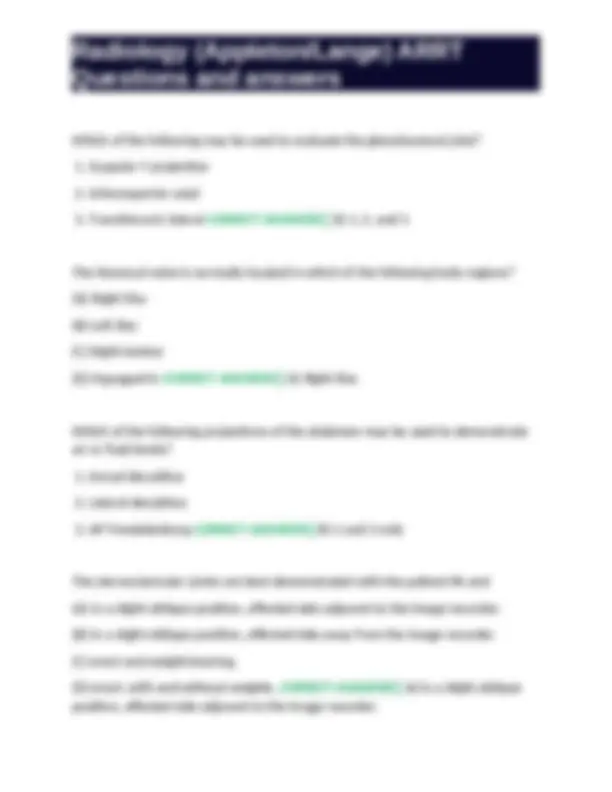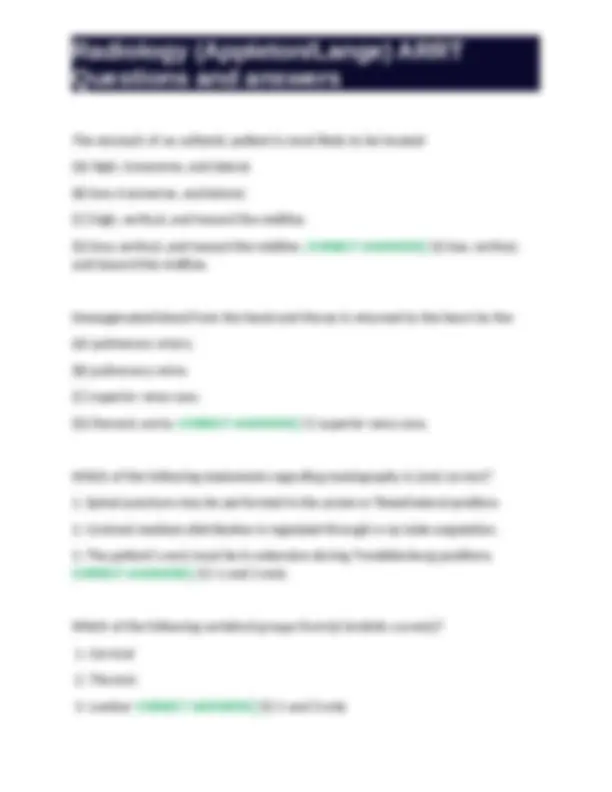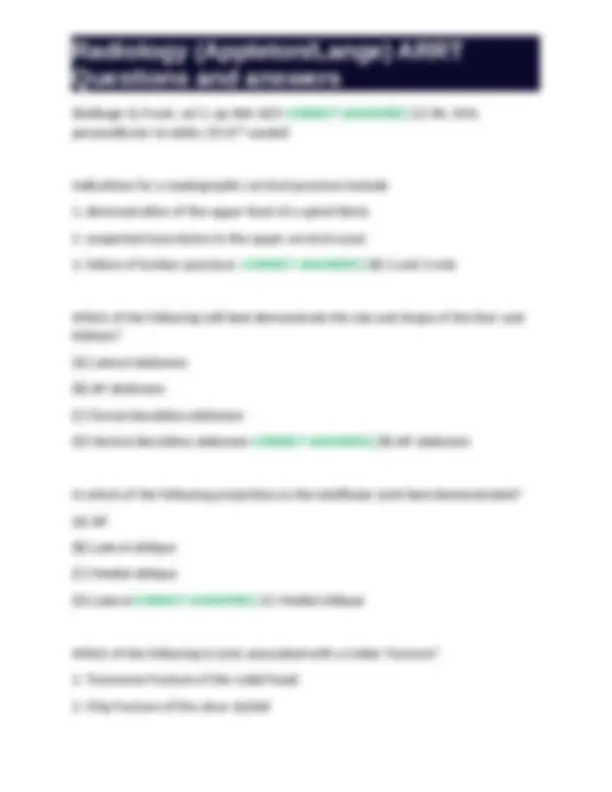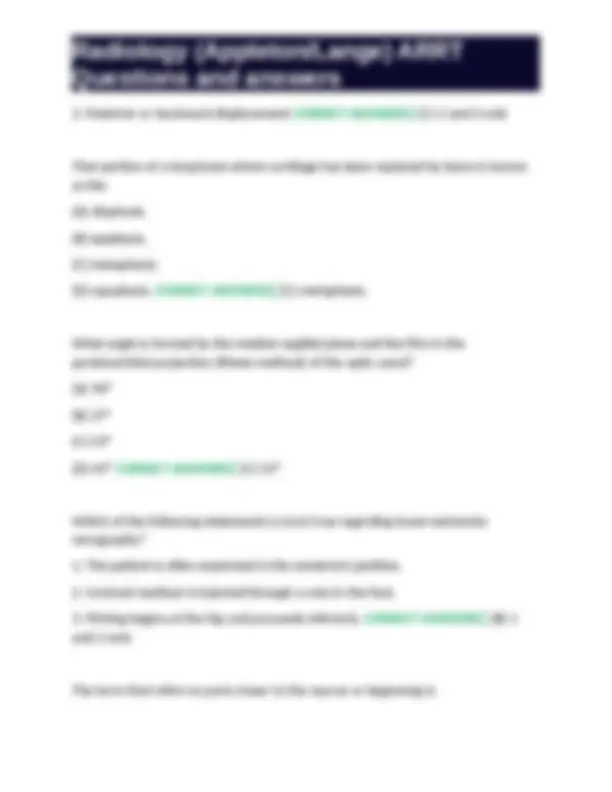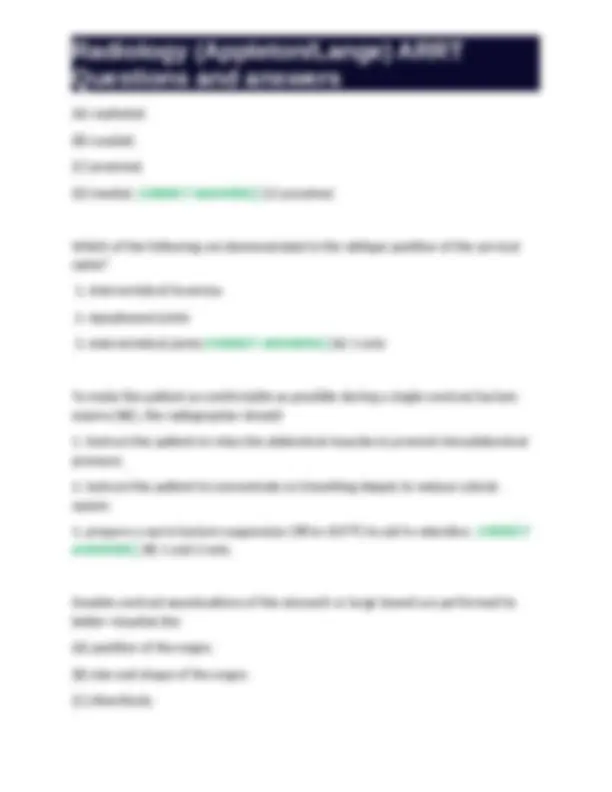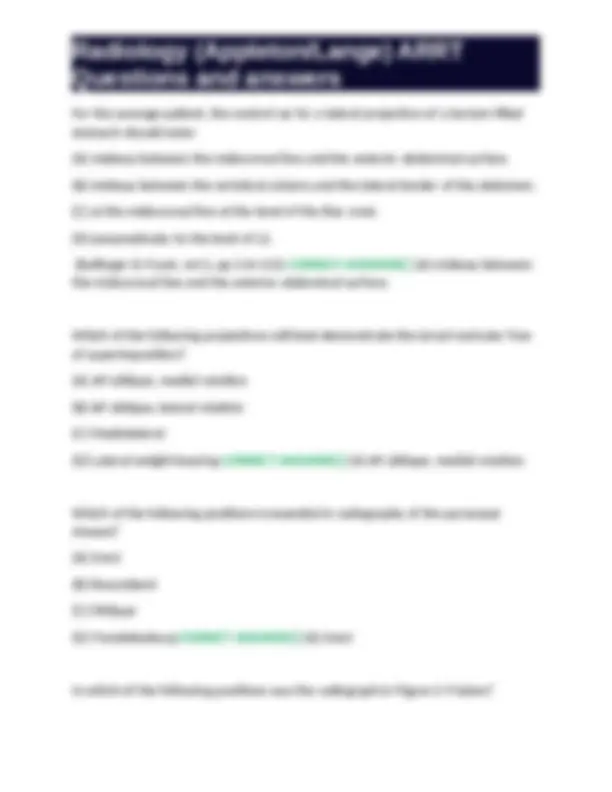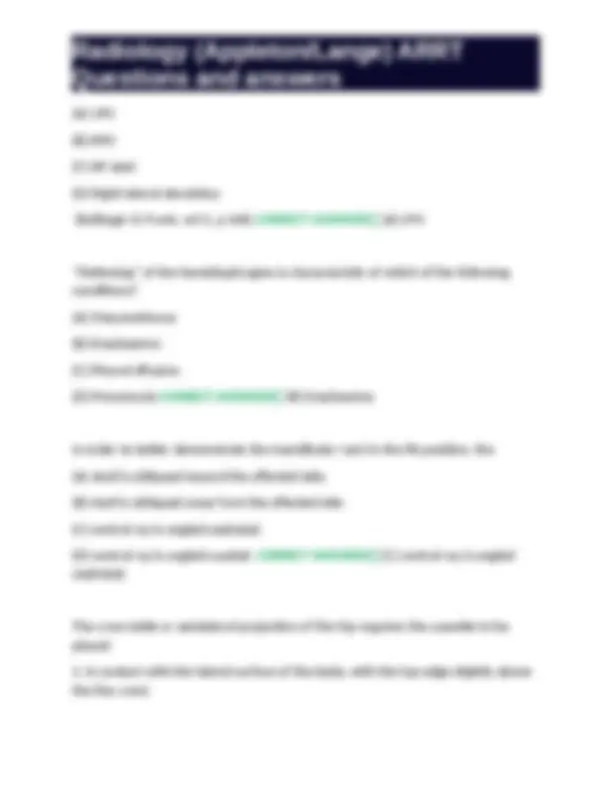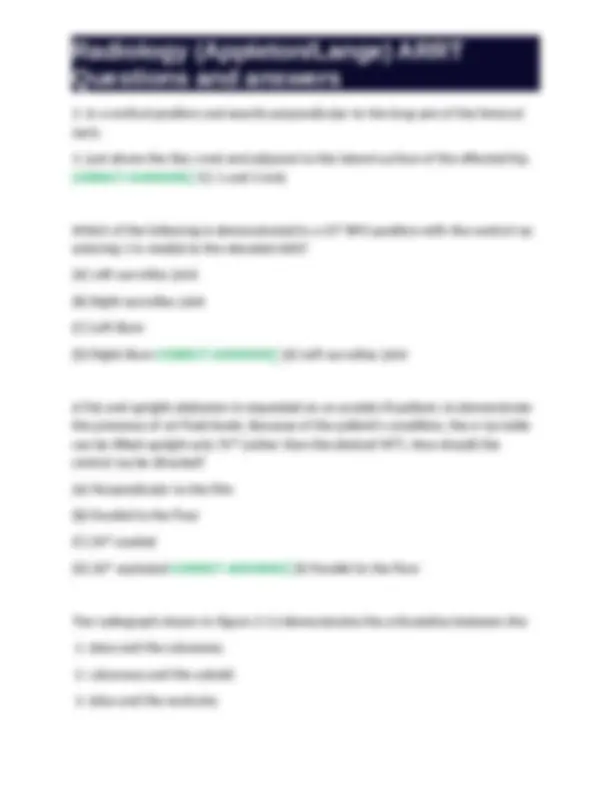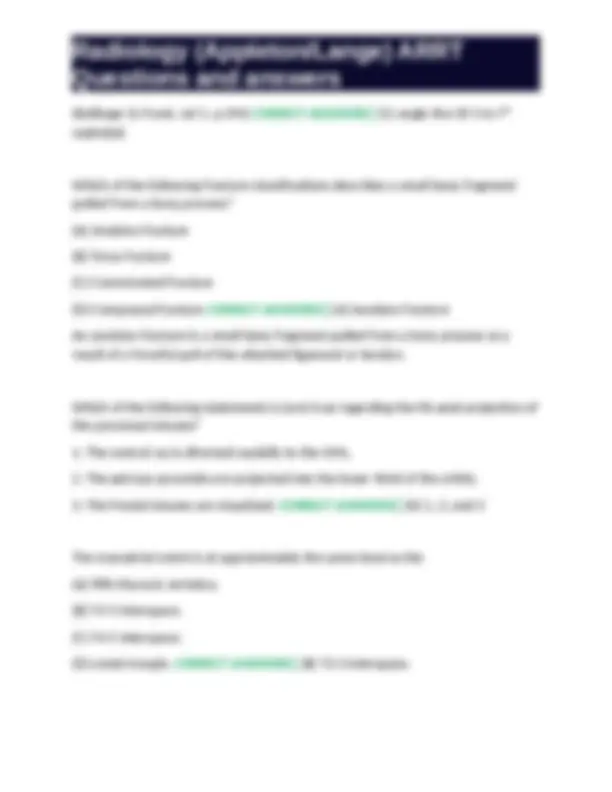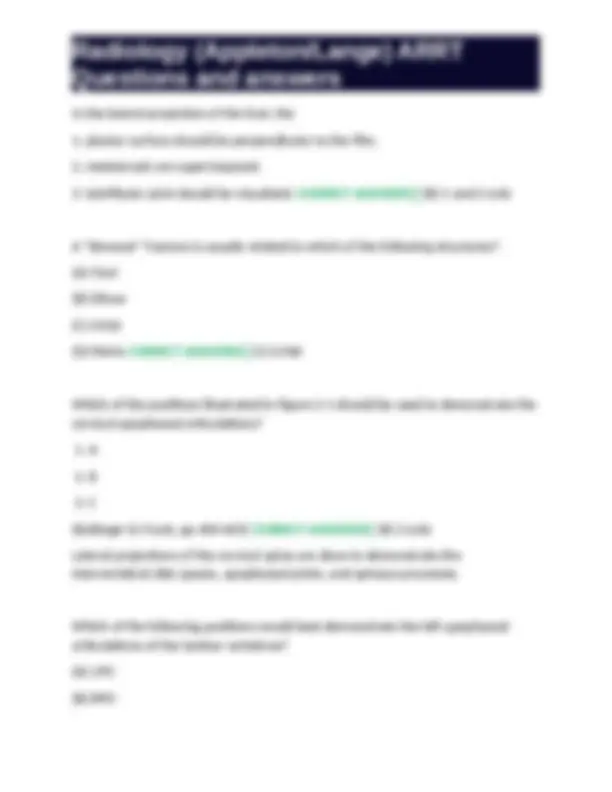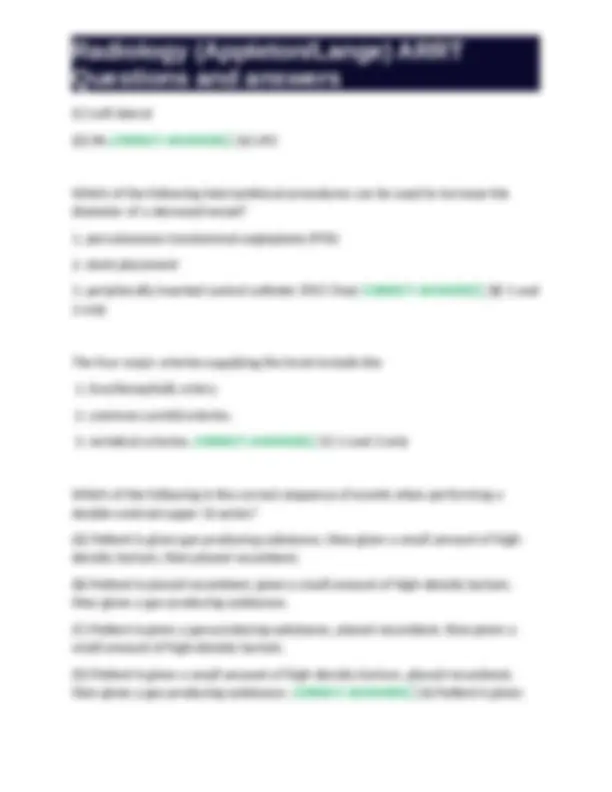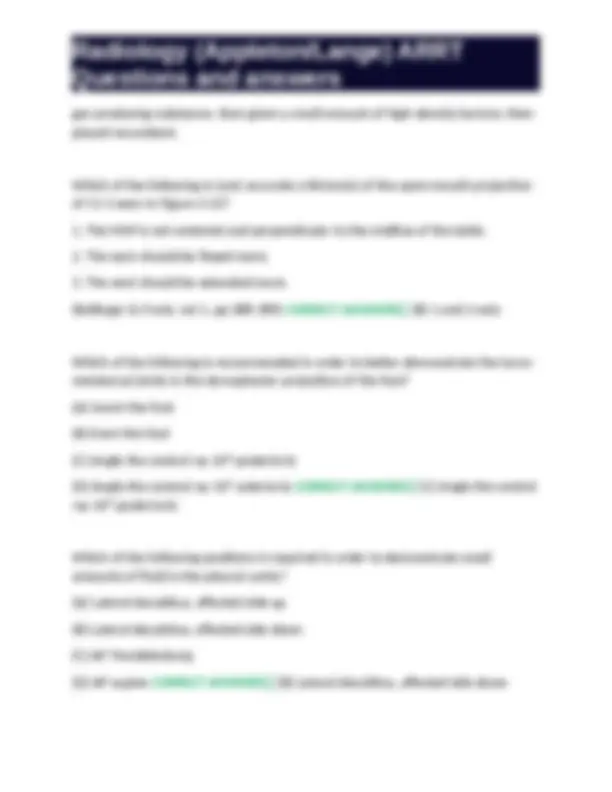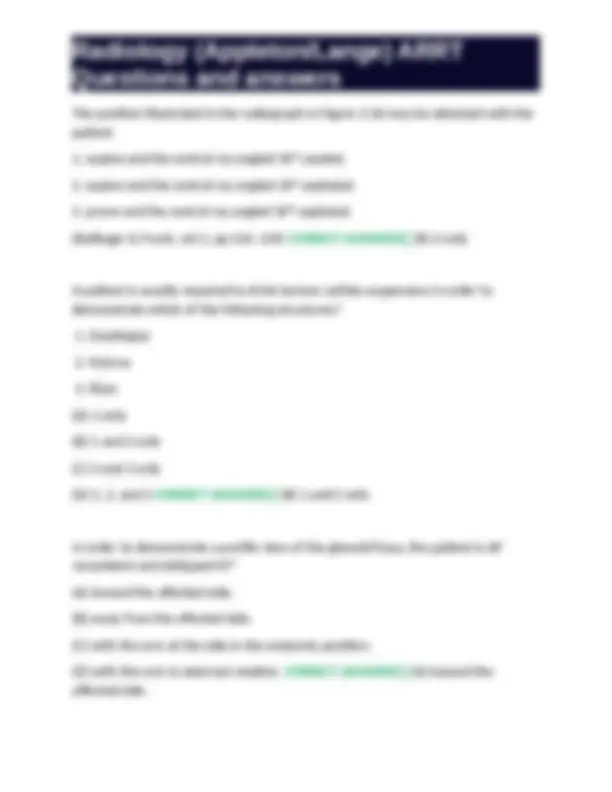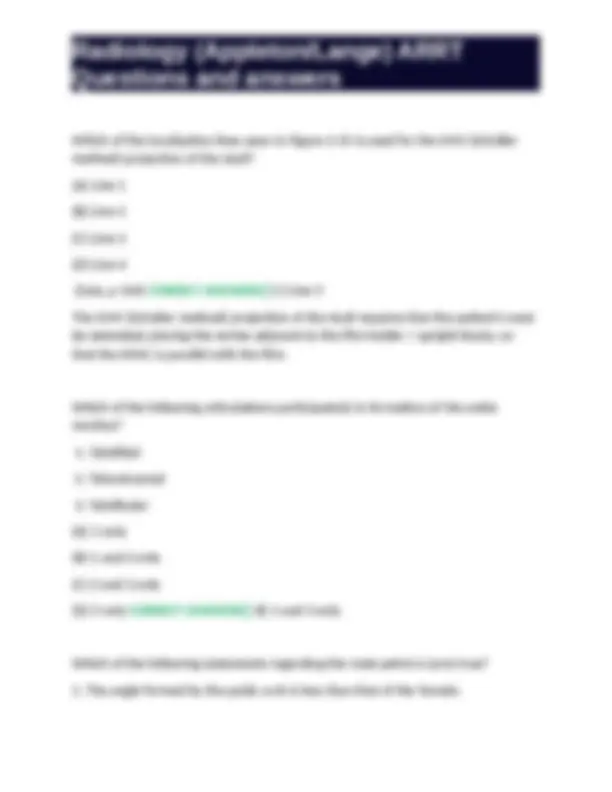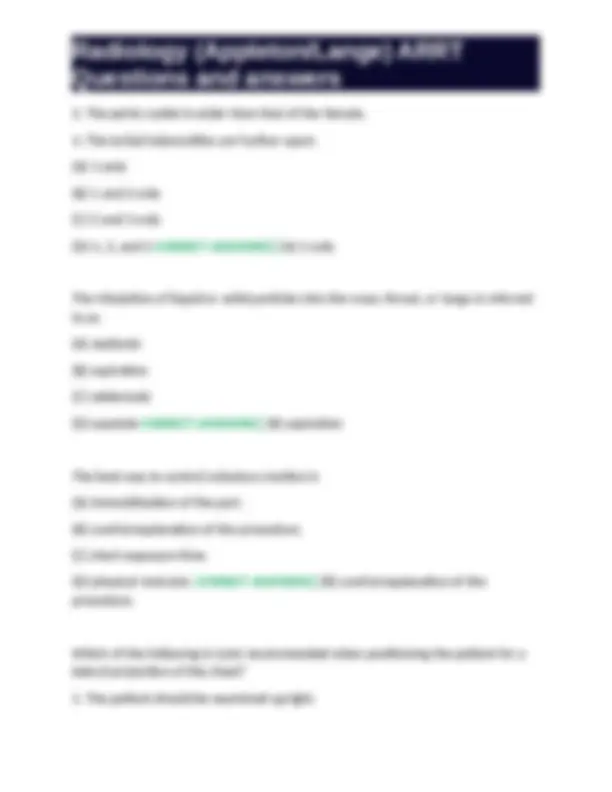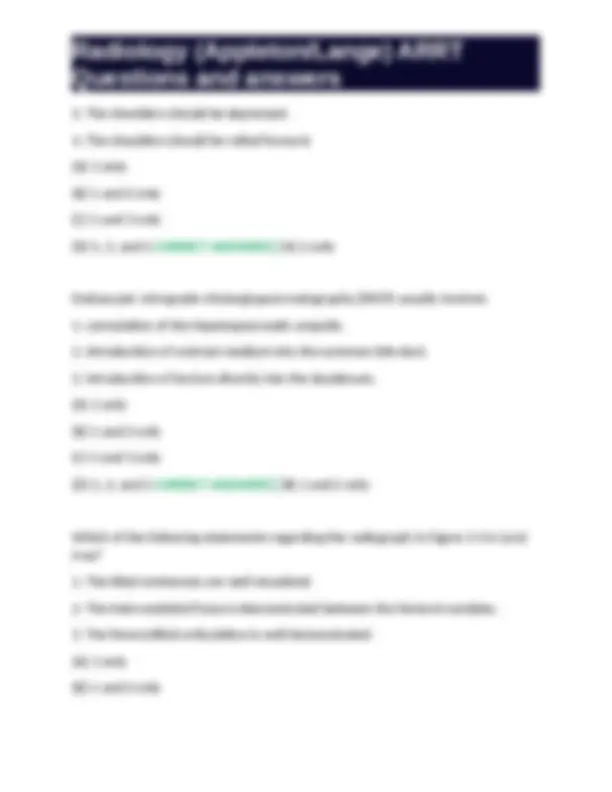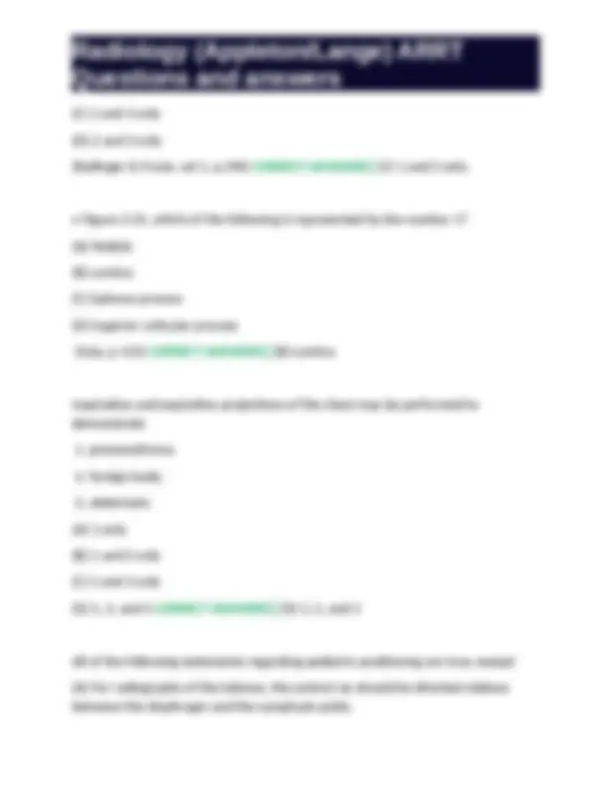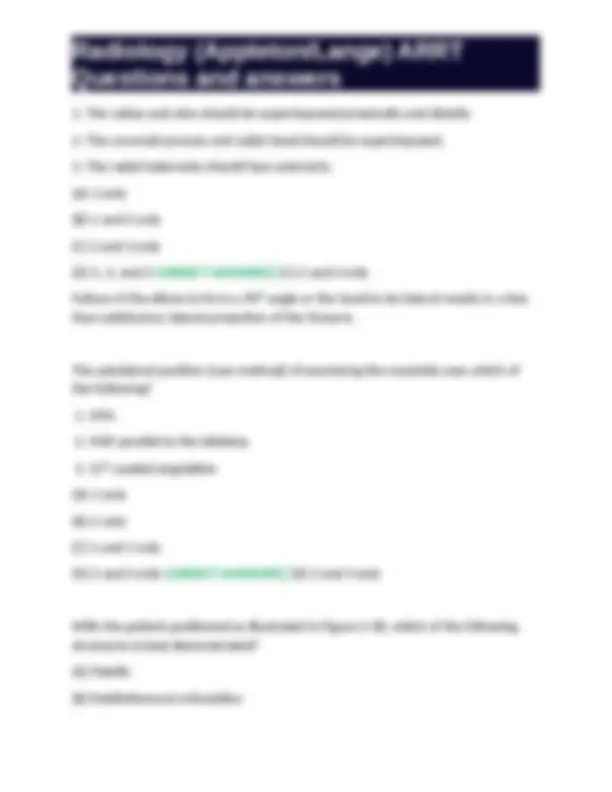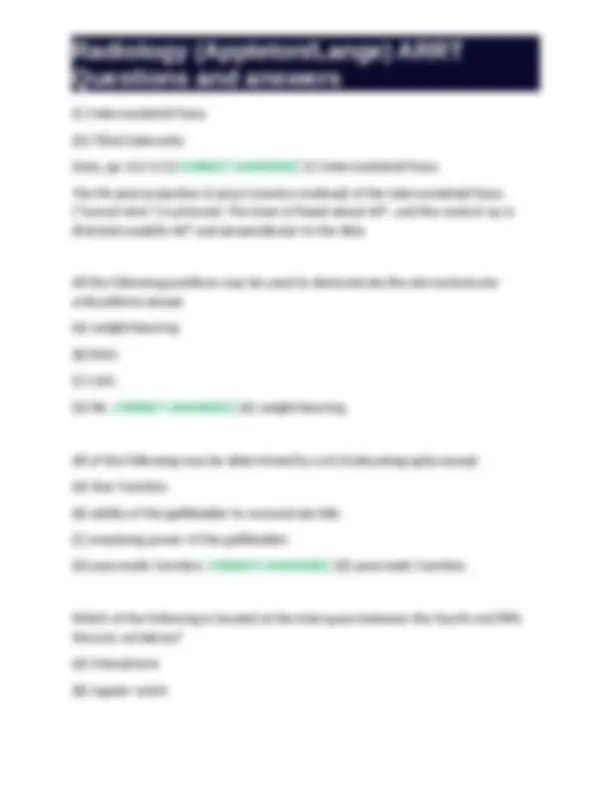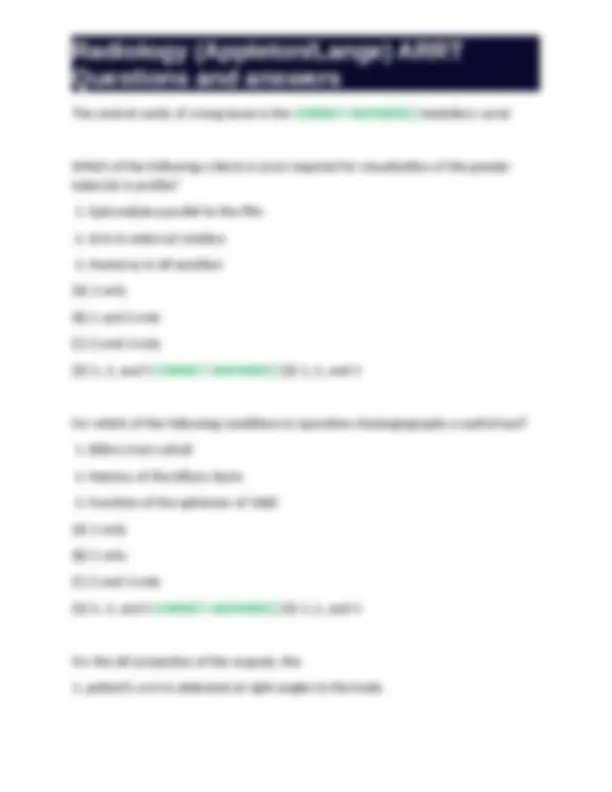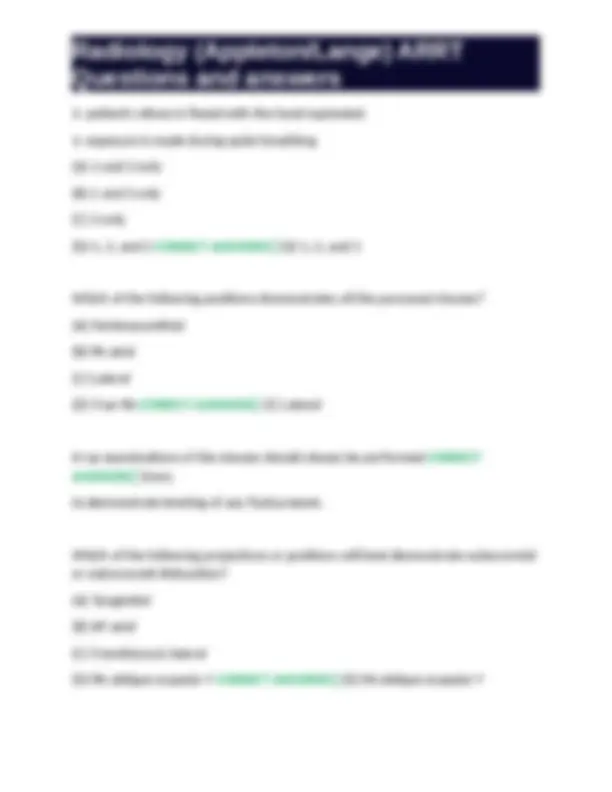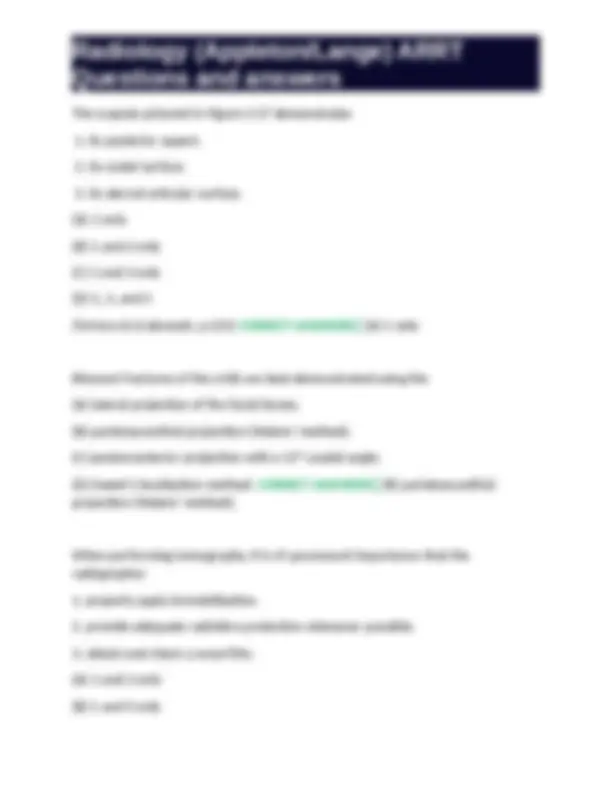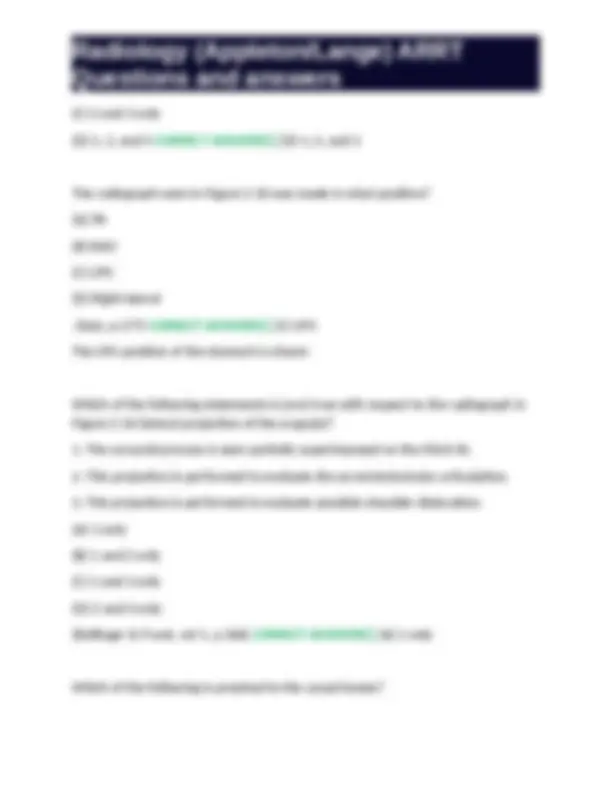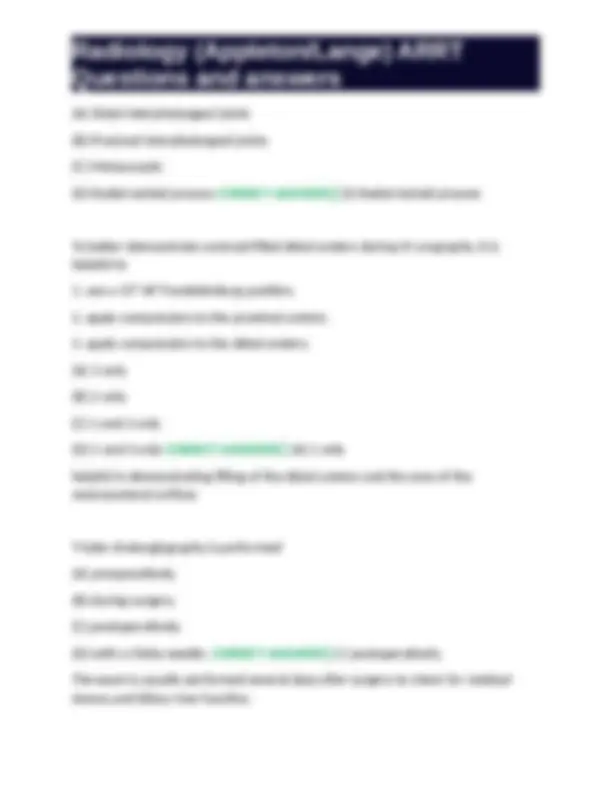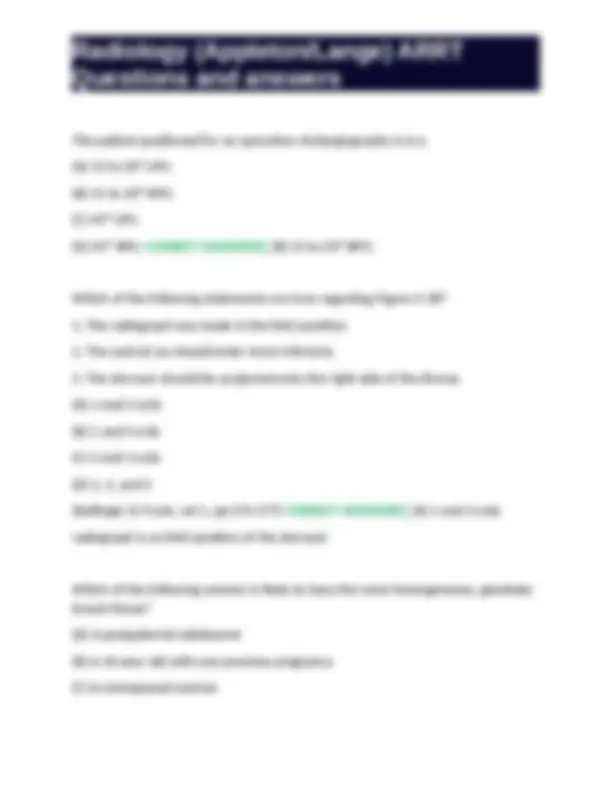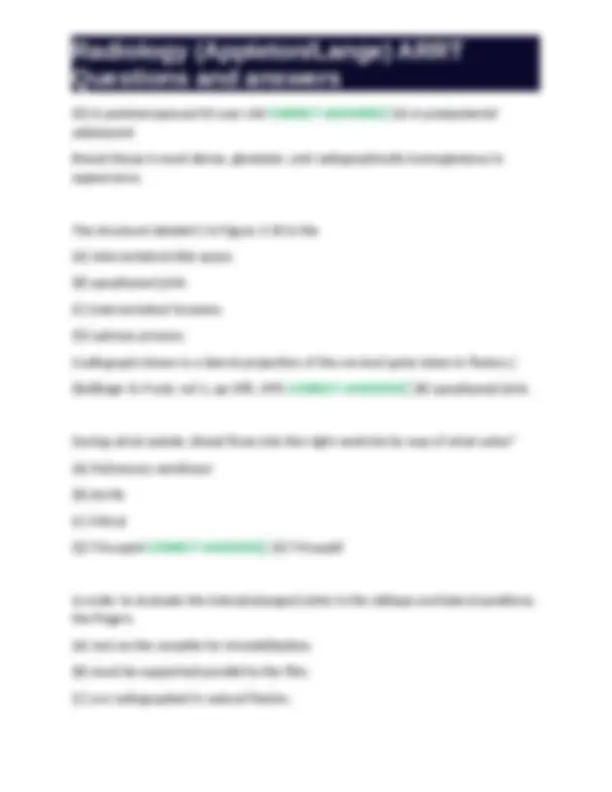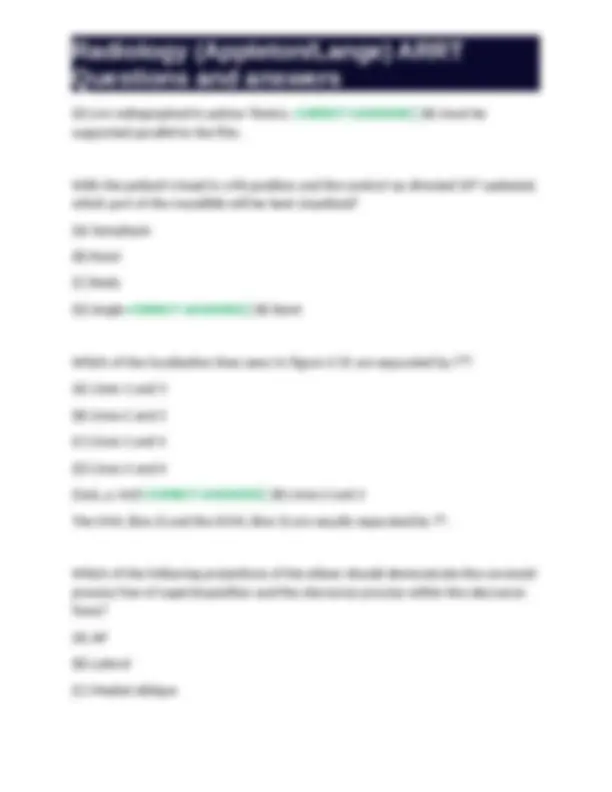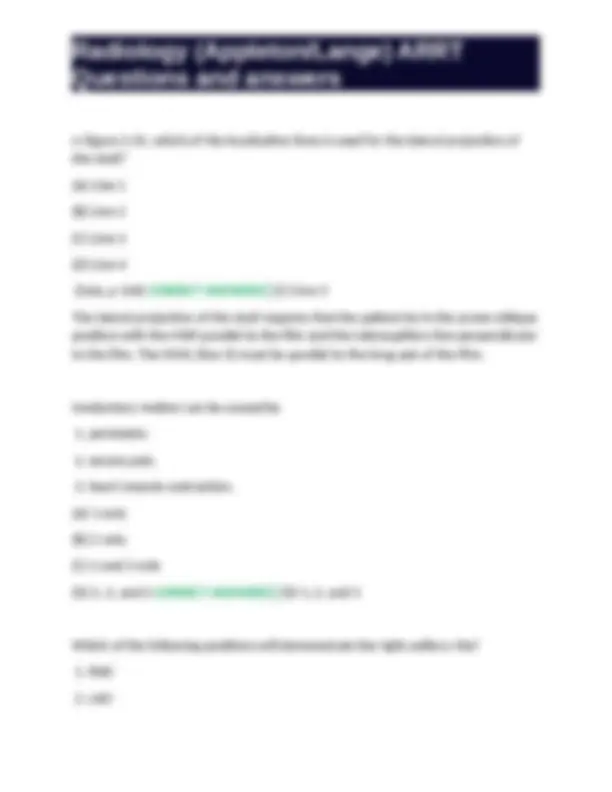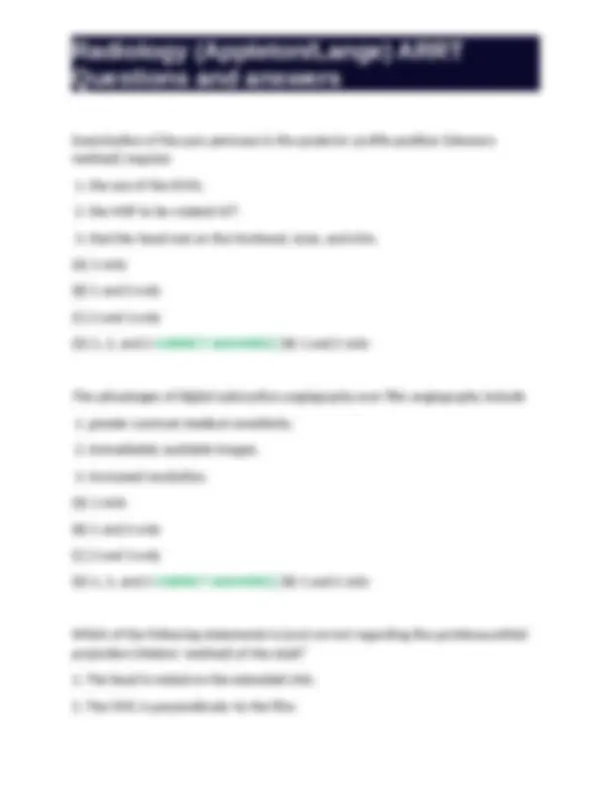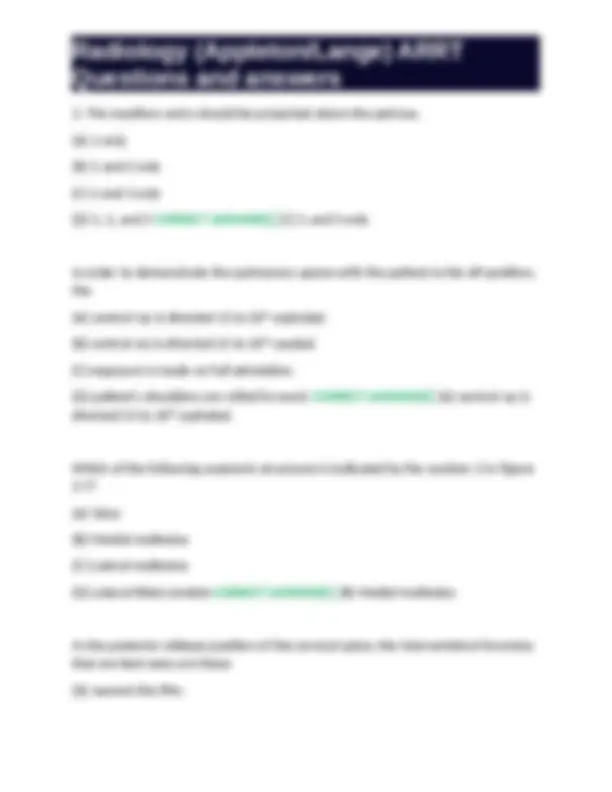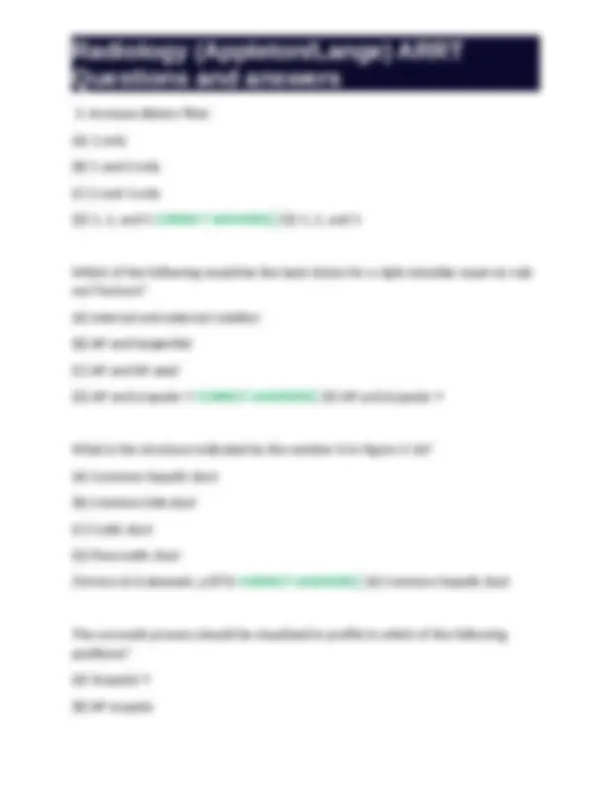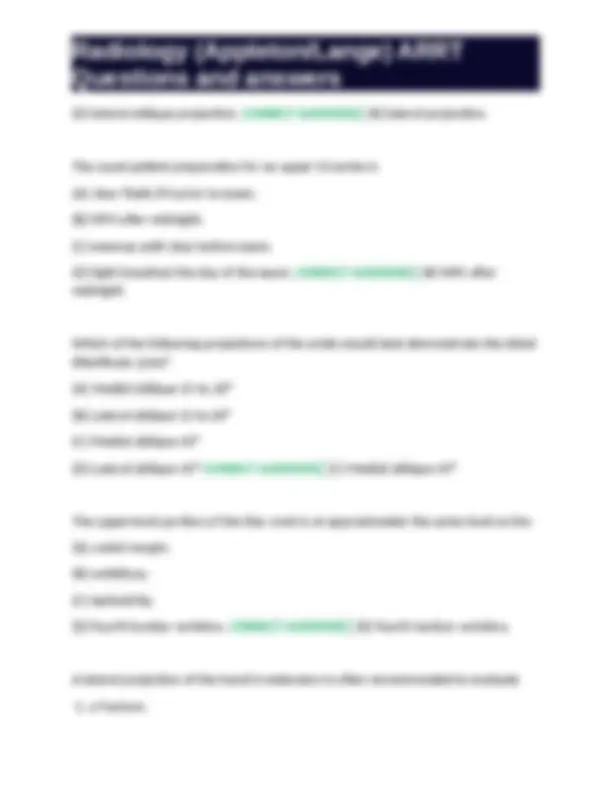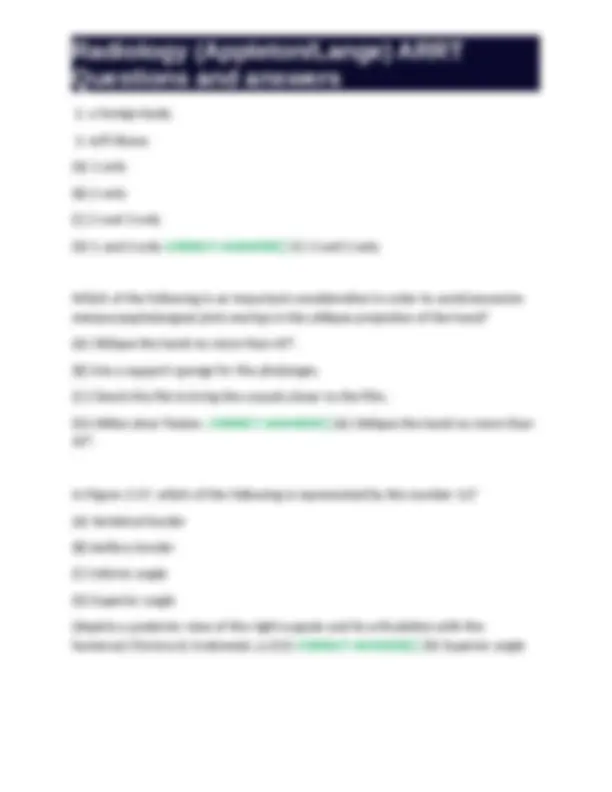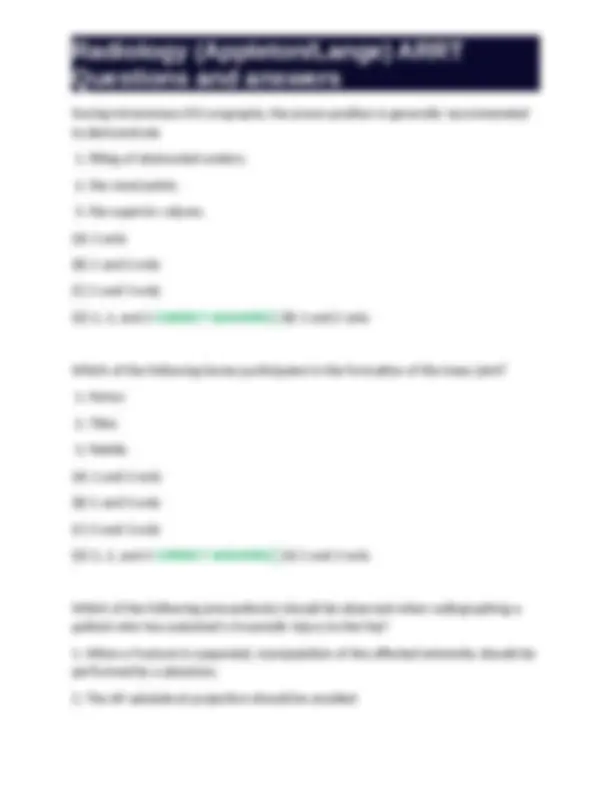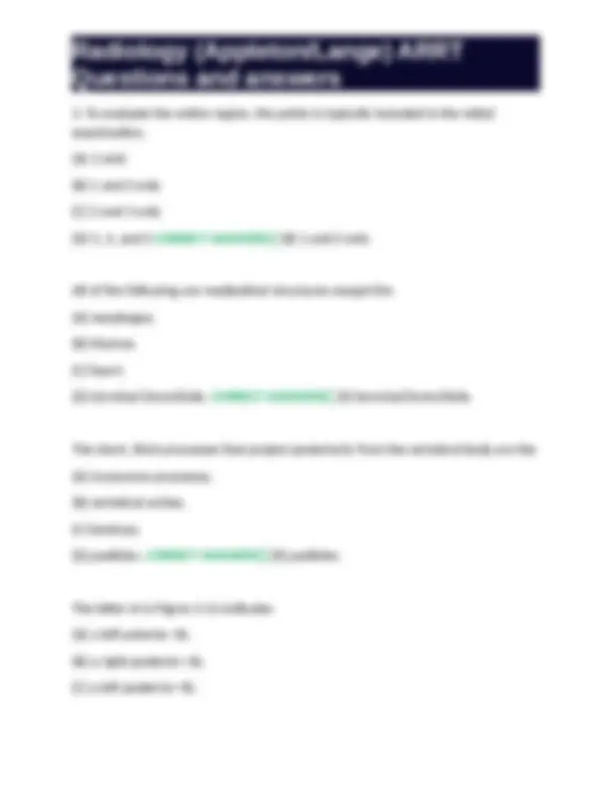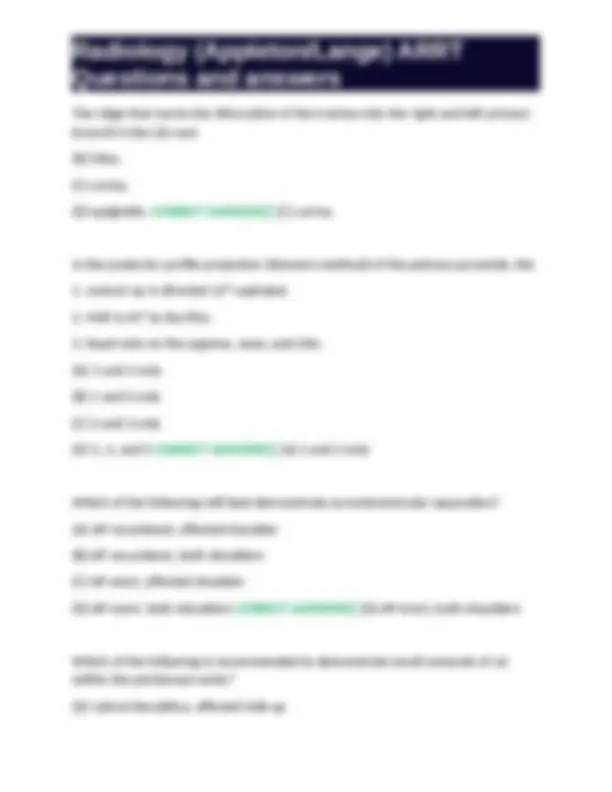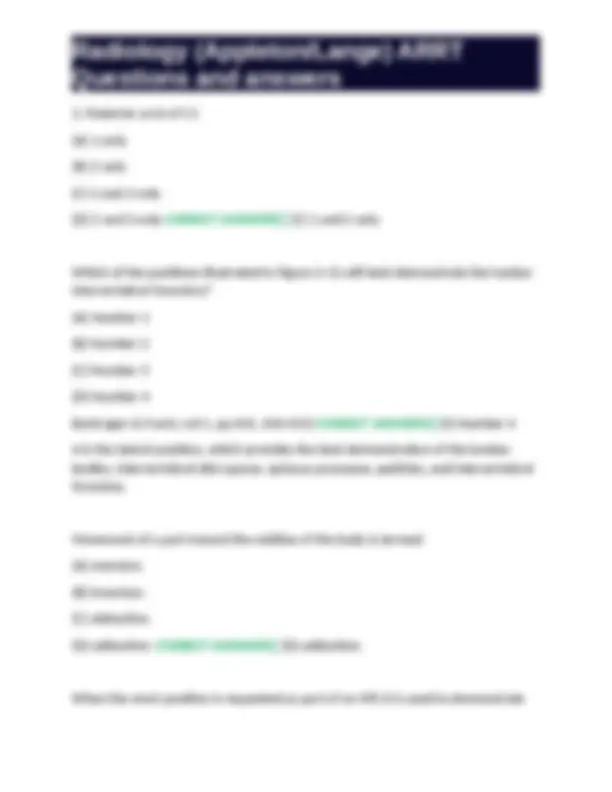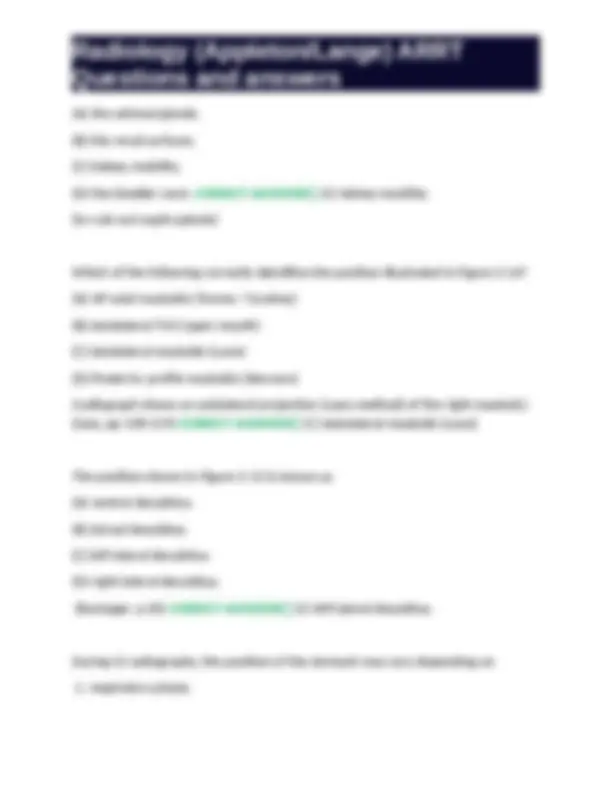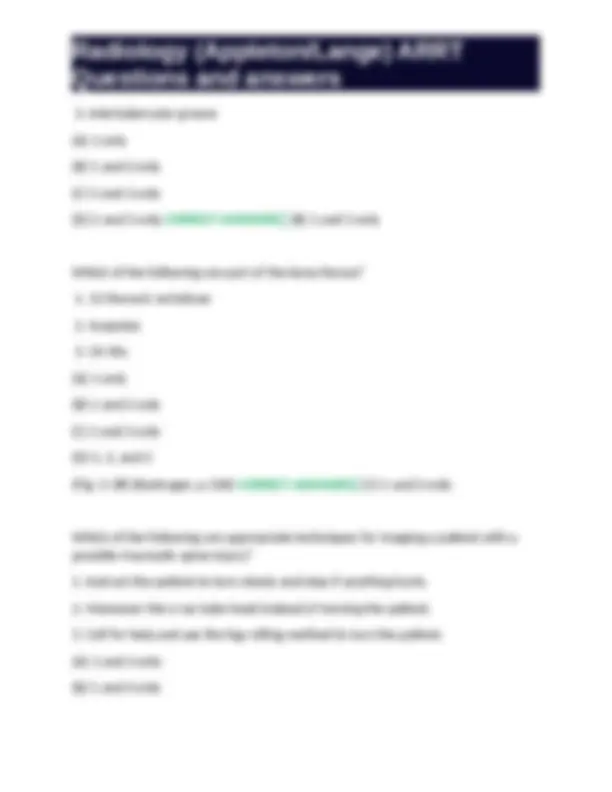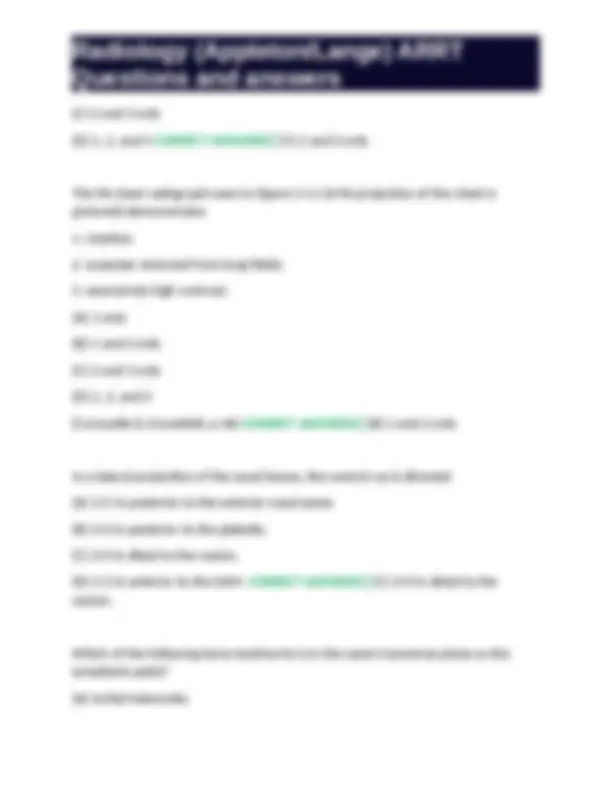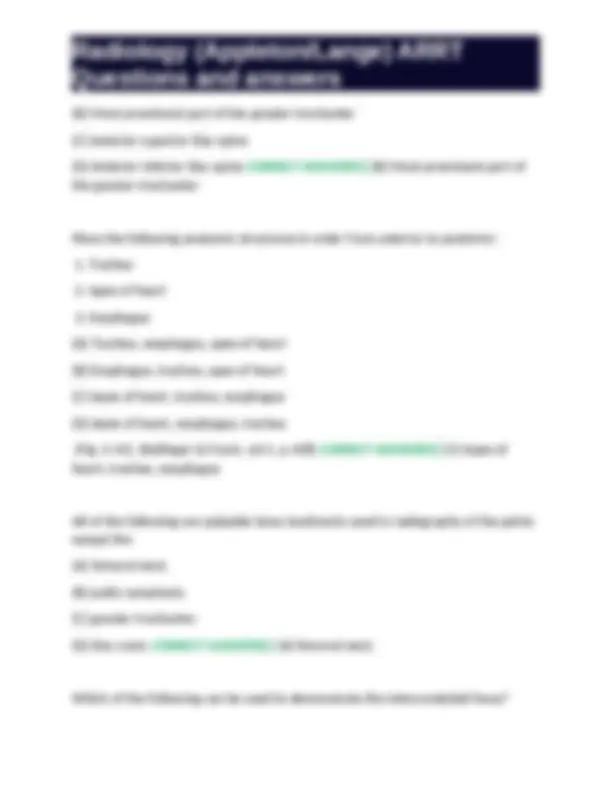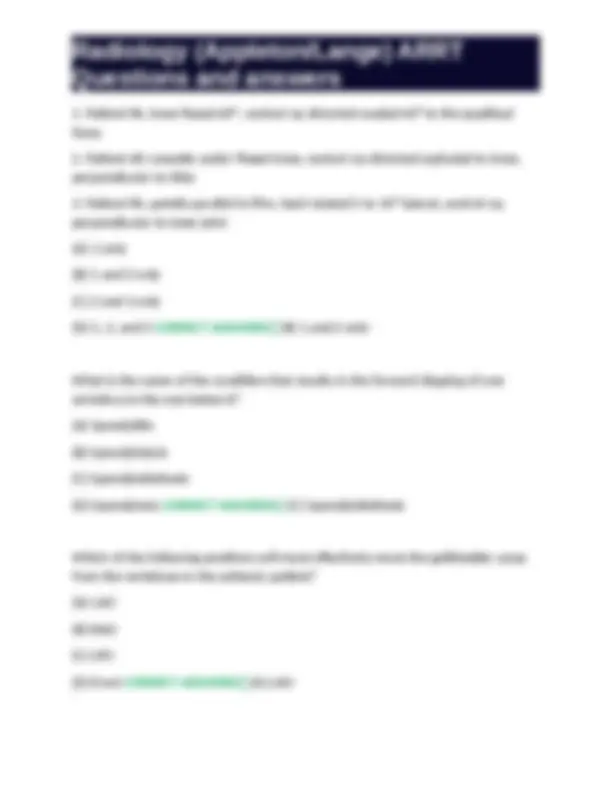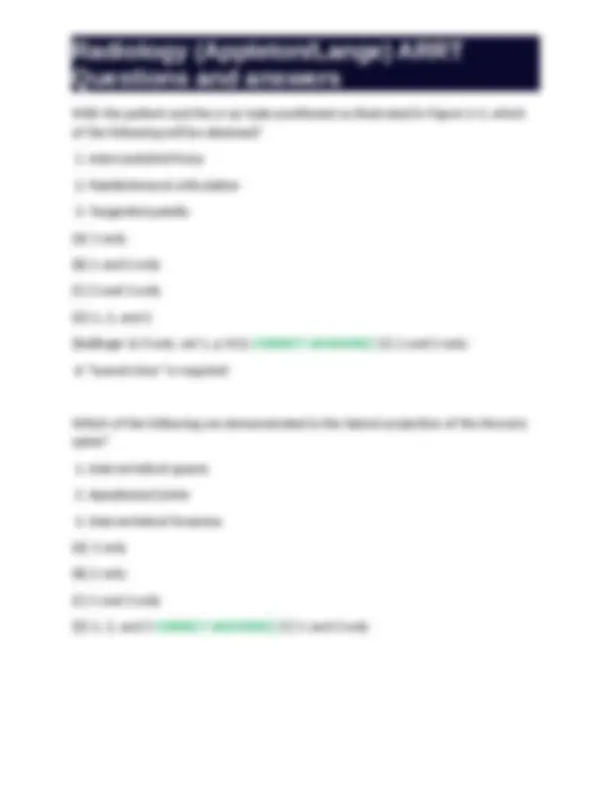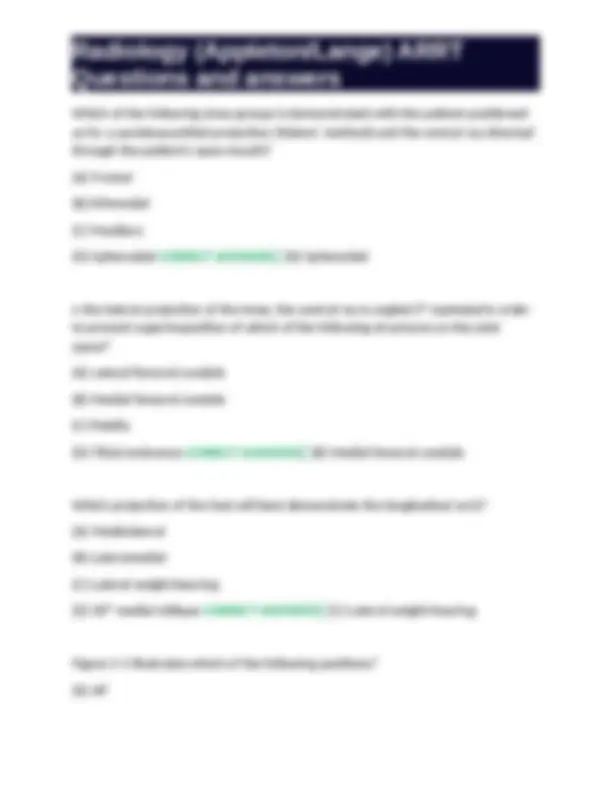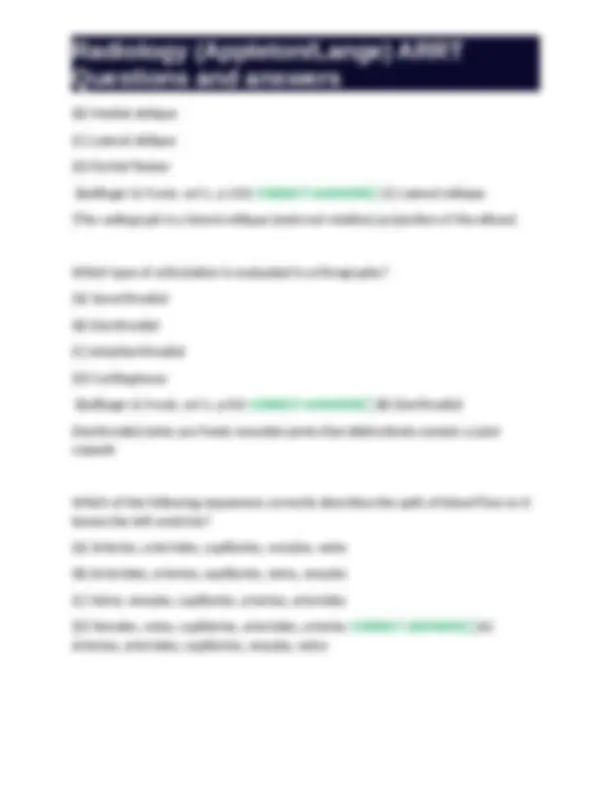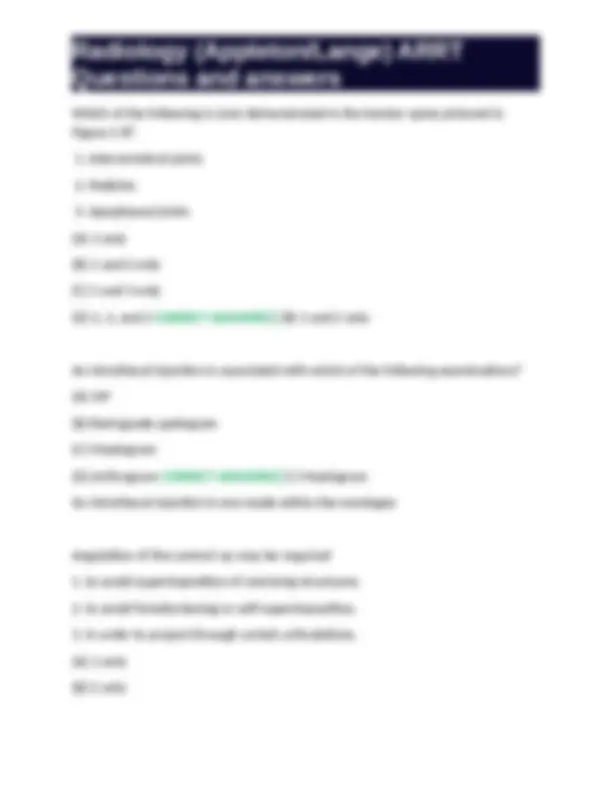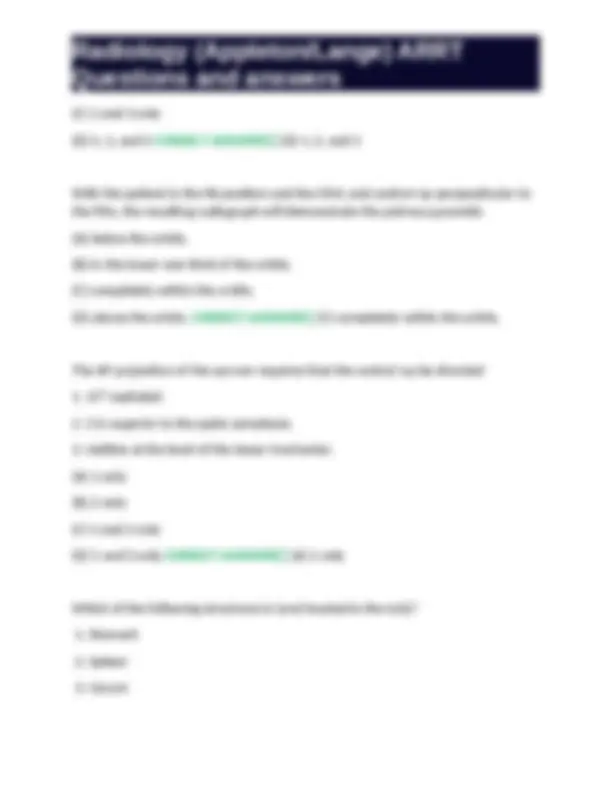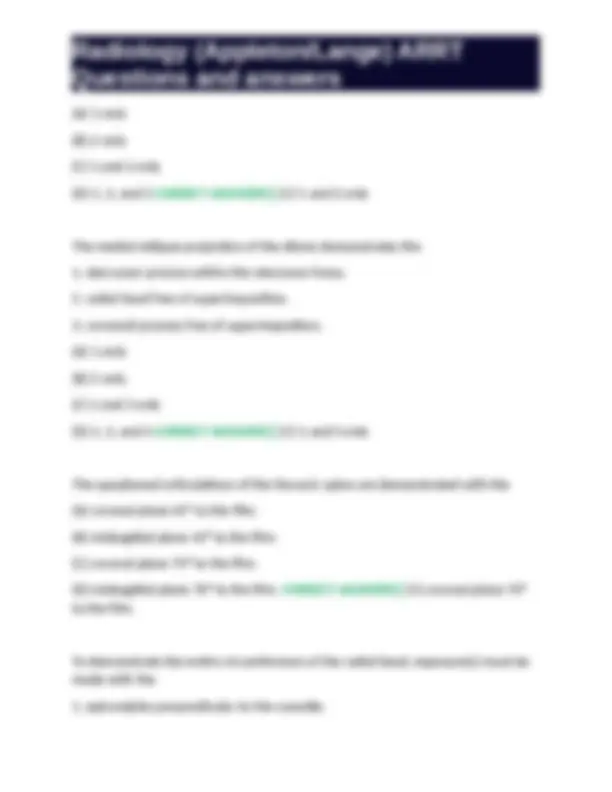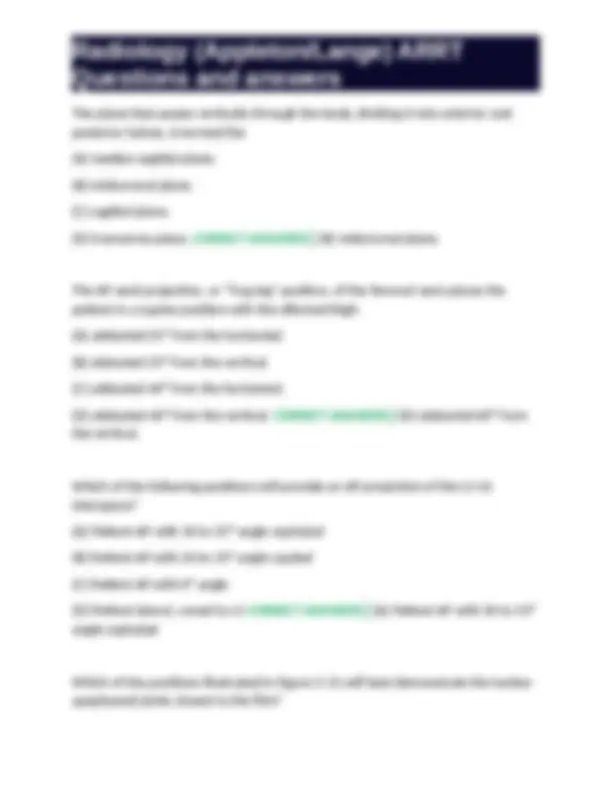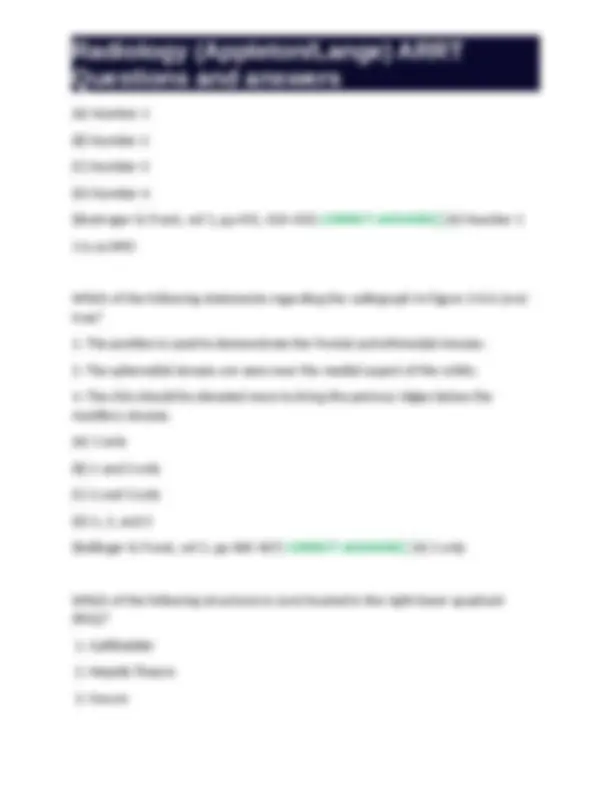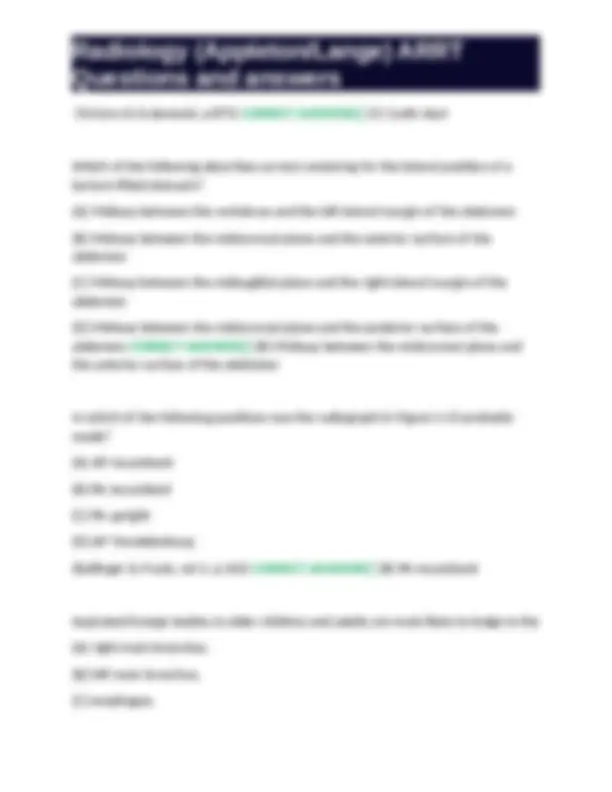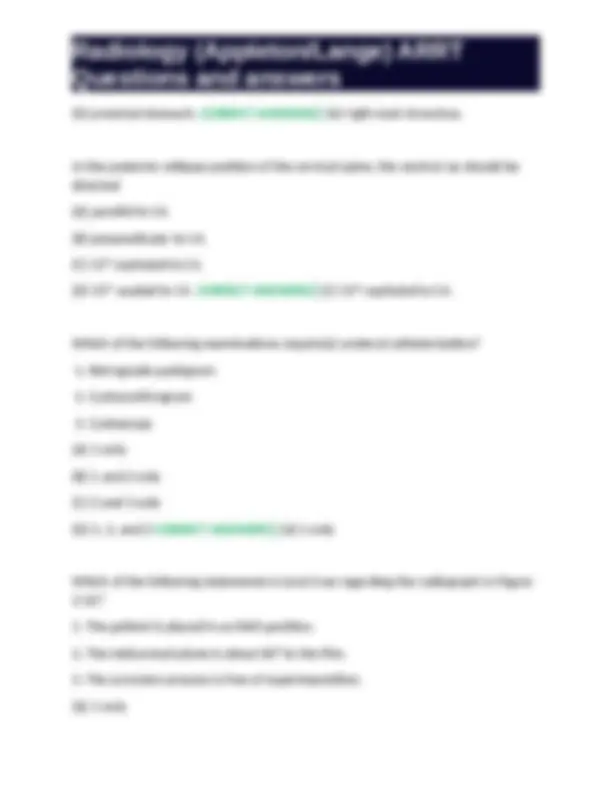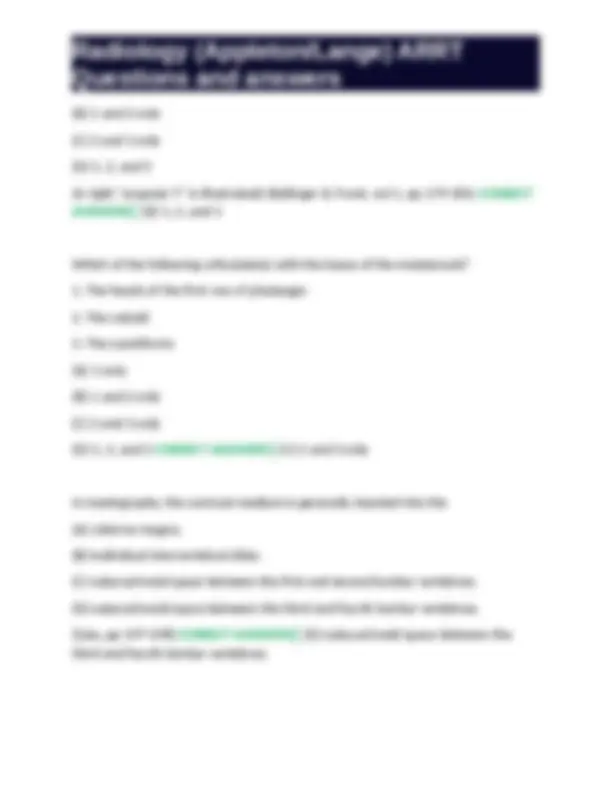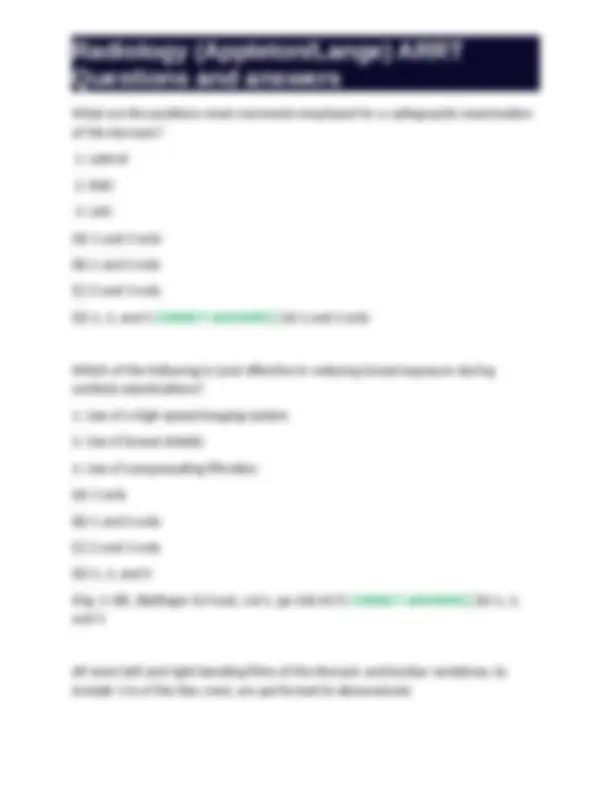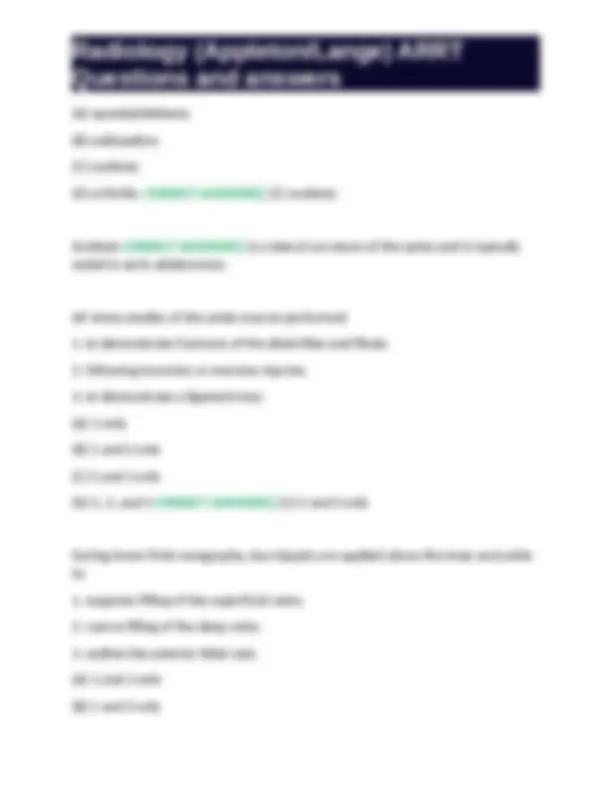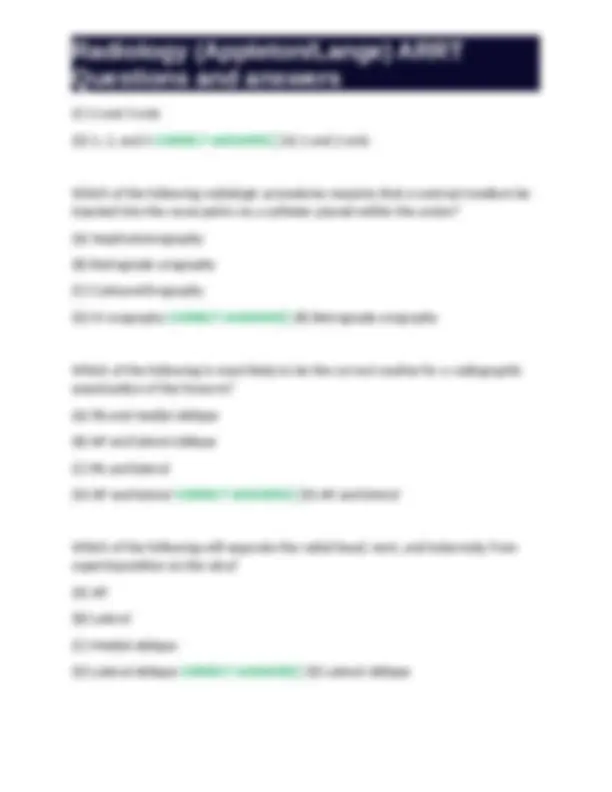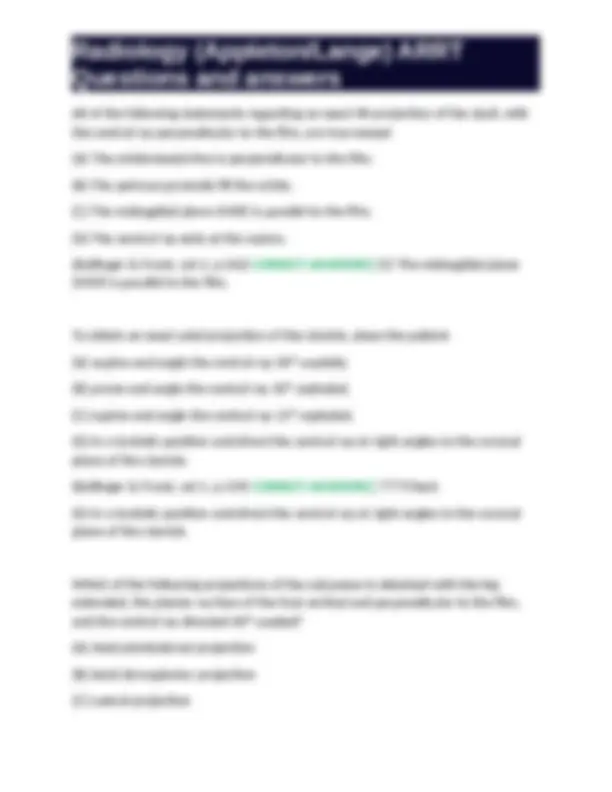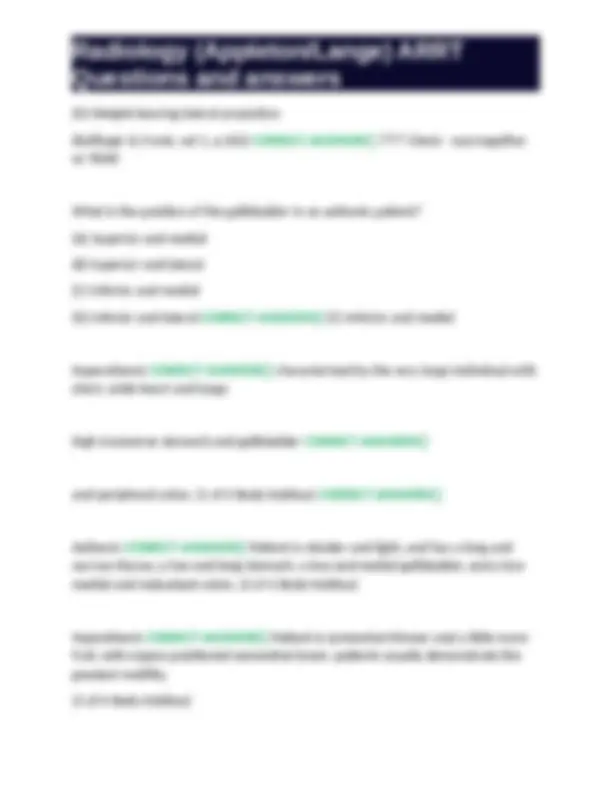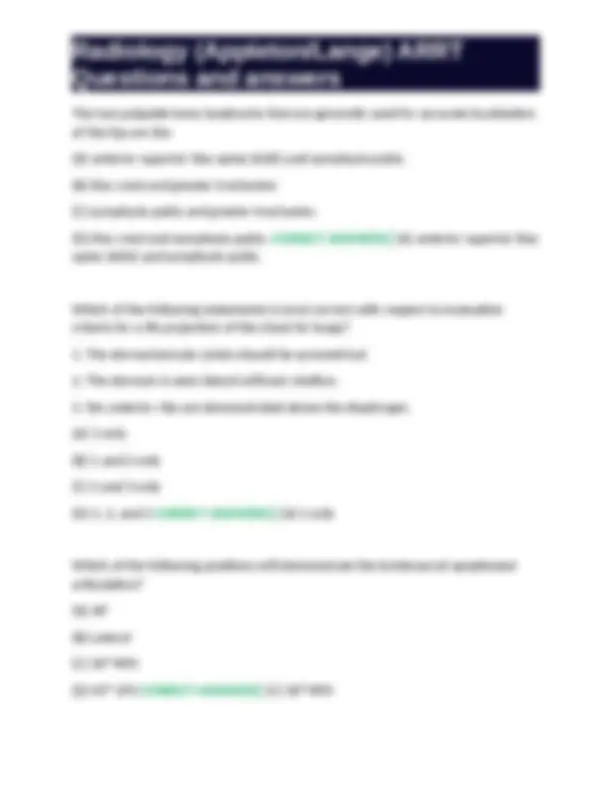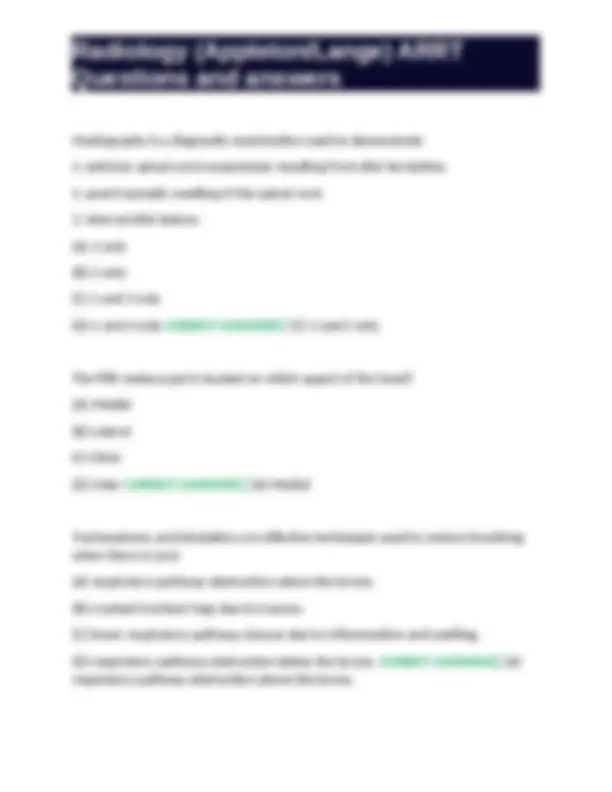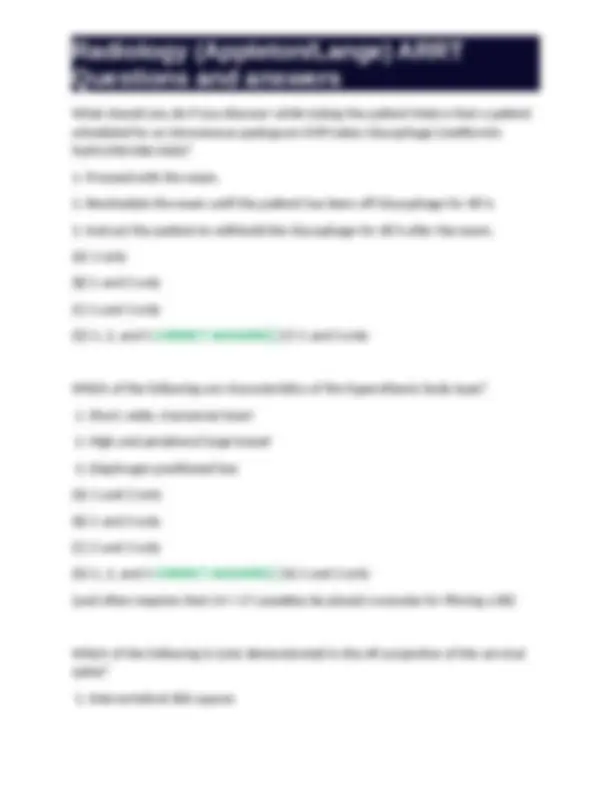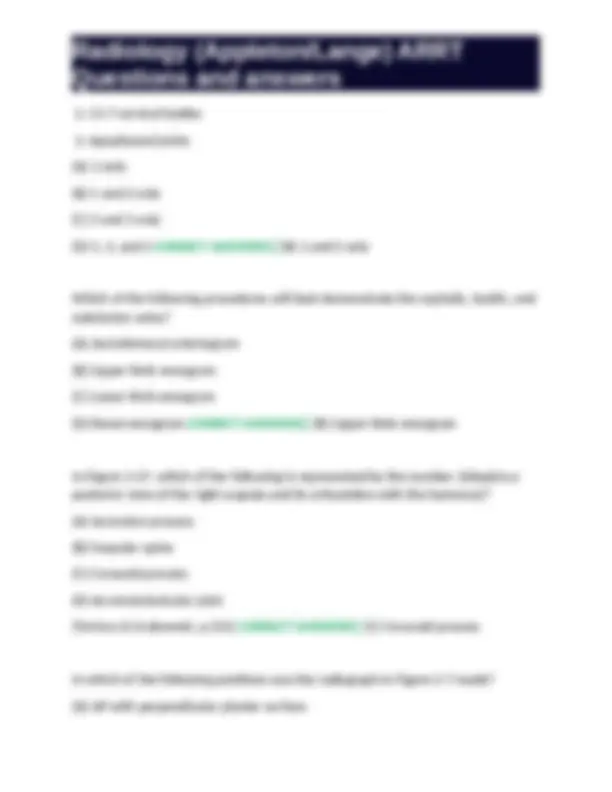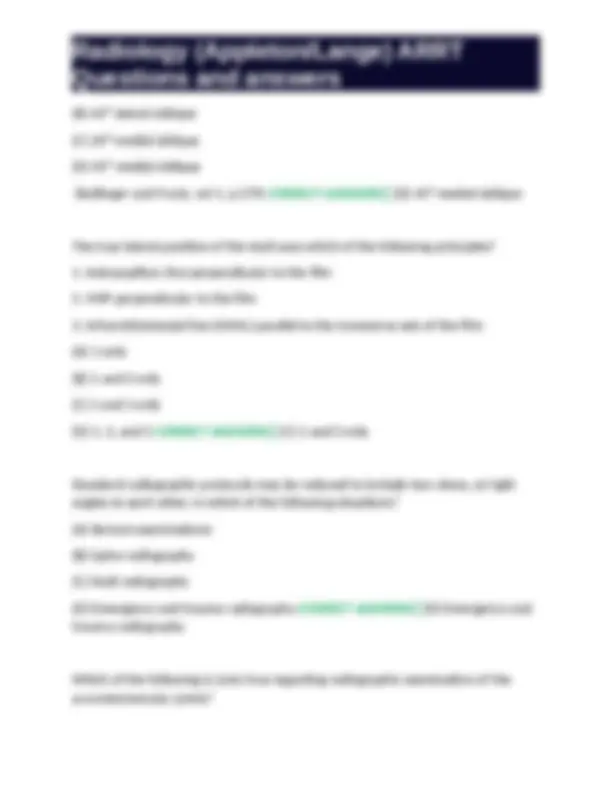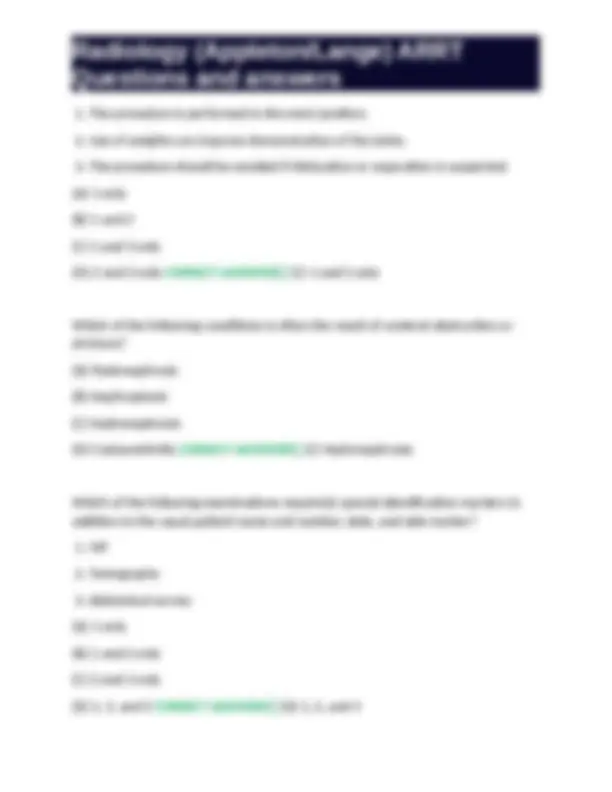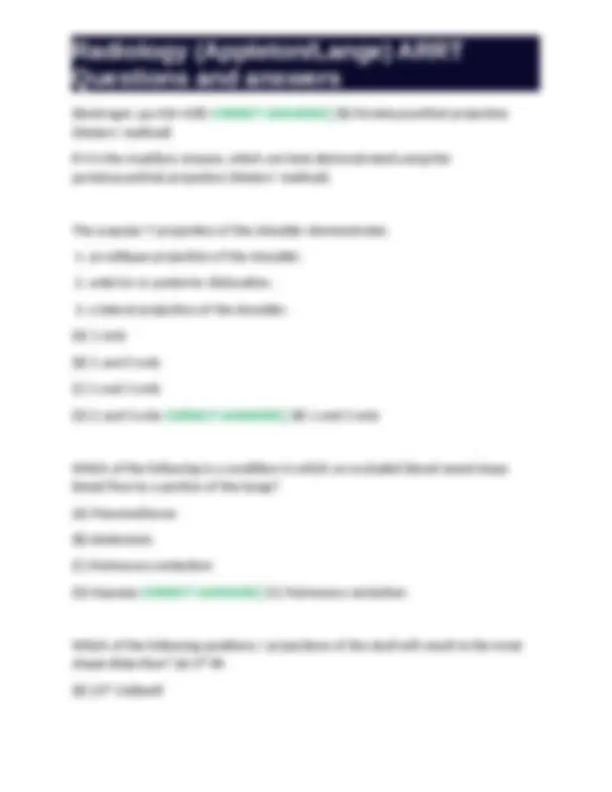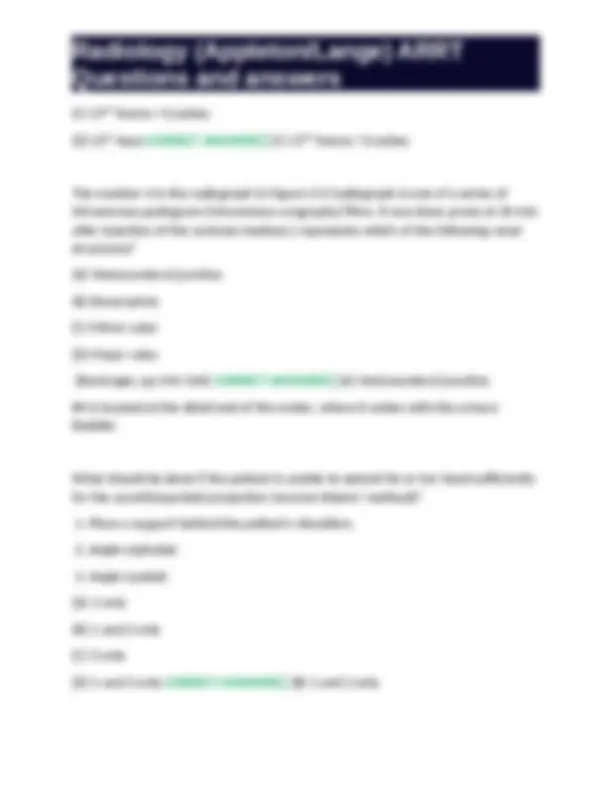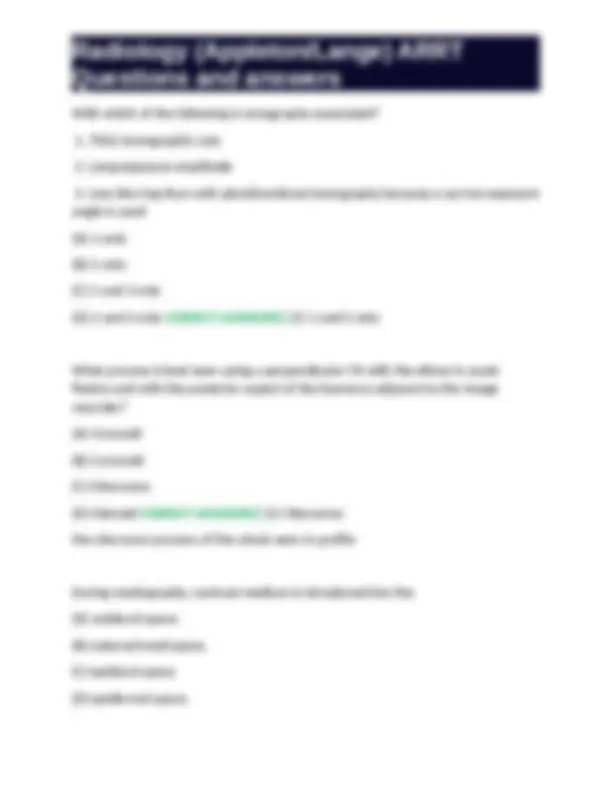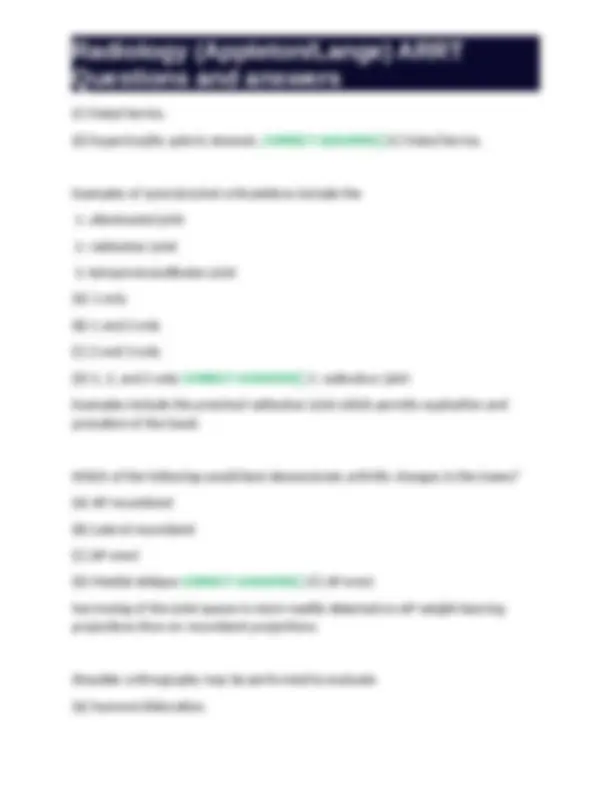Download Radiology (Appleton/Lange) ARRT Questions and answers and more Exams Radiography in PDF only on Docsity!
Questions and answers
The junction of the transverse colon and the descending colon forms the (A) hepatic flexure. (B) splenic flexure. (C) transverse flexure. (D) sigmoid flexure. (Ballinger & Frank, vol 2, p 89) CORRECT ANSWERS✅ (B) splenic flexure. All of the following statements regarding respiratory structures are true except (A) The right lung has two lobes. (B) The uppermost portion of the lung is the apex. (C) Each lung is enclosed in pleura. (D) The trachea bifurcates into mainstem bronchi. (Bontrager, pp 69-70) CORRECT ANSWERS✅ (A) The right lung has two lobes. When the patient is recumbent and the central ray is directed horizontally, the patient is said to be in the (A) Trendelenburg position. (B) Fowler's position. (C) decubitus position. (D) Sims position. CORRECT ANSWERS✅ (C) decubitus position. n the AP projection of the ankle, the
- plantar surface of the foot is vertical.
Questions and answers
- fibula projects more distally than the tibia.
- calcaneus is well visualized. CORRECT ANSWERS✅ (B) 1 and 2 only Which of the following positions would be obtained with the patient lying prone recumbent on the radiographic table, and the central ray directed horizontally to the iliac crest? (A) Ventral decubitus position (B) Dorsal decubitus position (C) Left lateral decubitus position (D) Right lateral decubitus position CORRECT ANSWERS✅ (A) Ventral decubitus position Which of the following is (are) required for a lateral projection of the skull?
- The IOML is parallel to the film.
- The MSP is perpendicular to the film.
- The central ray enters 2 in superior to the external auditory meatus (EAM). CORRECT ANSWERS✅ (B) 1 and 3 only Which of the following should be performed to rule out subluxation or fracture of the cervical spine? (A) Oblique cervical spine, seated (B) AP cervical spine, recumbent (C) Horizontal beam lateral (D) Laterals in flexion and extension CORRECT ANSWERS✅ C) Horizontal beam lateral
Questions and answers
The stomach of an asthenic patient is most likely to be located (A) high, transverse, and lateral. (B) low, transverse, and lateral. (C) high, vertical, and toward the midline. (D) low, vertical, and toward the midline. CORRECT ANSWERS✅ D) low, vertical, and toward the midline. Deoxygenated blood from the head and thorax is returned to the heart by the (A) pulmonary artery. (B) pulmonary veins. (C) superior vena cava. (D) thoracic aorta. CORRECT ANSWERS✅ C) superior vena cava. Which of the following statements regarding myelography is (are) correct?
- Spinal puncture may be performed in the prone or flexed lateral position.
- Contrast medium distribution is regulated through x-ray tube angulation.
- The patient's neck must be in extension during Trendelenburg positions. CORRECT ANSWERS✅ (C) 1 and 3 only Which of the following vertebral groups form(s) lordotic curve(s)?
- Cervical
- Thoracic
- Lumbar CORRECT ANSWERS✅ D) 1 and 3 only
Questions and answers
Which of the following techniques would provide a PA projection of the gastroduodenal surfaces of the barium-filled, high and transverse stomach? (A) Place the patient in a 35 to 40º RAO position. (B) Place the patient in a lateral position. (C) Angle the central ray 35 to 45º cephalad. (D) Angle the central ray 35 to 45º caudad. CORRECT ANSWERS✅ C) Angle the central ray 35 to 45º cephalad. Which of the following structures is (are) most likely to be demonstrated in a right lateral decubitus position of a double-contrast BE?
- Lateral wall of the descending colon
- Medial wall of the ascending colon
- Lateral wall of the ascending colon (Saia, pp 180, 181) CORRECT ANSWERS✅ C) 1 and 2 only To demonstrate esophageal varices, the patient must be examined in (A) the recumbent position. (B) the erect position. (C) the anatomic position. (D) Fowler's position. CORRECT ANSWERS✅ A) the recumbent position. The contraction and expansion of arterial walls in accordance with forceful contraction and relaxation of the heart is called
Questions and answers
- Hepatic flexure and descending colon (Ballinger & Frank, vol 2, p 141) CORRECT ANSWERS✅ (A) 1 only Which of the following is represented by the number 3 in Figure 2-34? (A) Inferior vena cava (B) Aorta (C) Gallbladder (D) Psoas muscle (Bontrager, p 100) CORRECT ANSWERS✅ (B) Aorta In what position was the radiograph in Figure 2-30 made? (A) Flexion (B) Extension (C) Left bending (D) Right bending (Ballinger & Frank, vol 1, pp 398, 399) CORRECT ANSWERS✅ A) Flexion In which of the following ways was the image seen in Figure 2-6 obtained? (A) PA, chin extended, OML forming 37º to table (B) PA, OML and central ray (CR) perpendicular to table (C) PA, OML perpendicular to table, CR 25º caudad (D) PA, OML perpendicular to table, CR 25º cephalad
Questions and answers
(Ballinger & Frank, vol 2, pp 366-367) CORRECT ANSWERS✅ (C) PA, OML perpendicular to table, CR 25º caudad Indications for a myelographic cervical puncture include
- demonstration of the upper level of a spinal block.
- suspected mass lesion in the upper cervical canal.
- failure of lumbar puncture. CORRECT ANSWERS✅ (B) 1 and 3 only Which of the following will best demonstrate the size and shape of the liver and kidneys? (A) Lateral abdomen (B) AP abdomen (C) Dorsal decubitus abdomen (D) Ventral decubitus abdomen CORRECT ANSWERS✅ (B) AP abdomen In which of the following projections is the talofibular joint best demonstrated? (A) AP (B) Lateral oblique (C) Medial oblique (D) Lateral CORRECT ANSWERS✅ (C) Medial oblique Which of the following is (are) associated with a Colles' fracture?
- Transverse fracture of the radial head
- Chip fracture of the ulnar styloid
Questions and answers
(A) cephalad. (B) caudad. (C) proximal. (D) medial. CORRECT ANSWERS✅ (C) proximal. Which of the following are demonstrated in the oblique position of the cervical spine?
- Intervertebral foramina
- Apophyseal joints
- Intervertebral joints CORRECT ANSWERS✅ (A) 1 only To make the patient as comfortable as possible during a single-contrast barium enema (BE), the radiographer should
- instruct the patient to relax the abdominal muscles to prevent intraabdominal pressure.
- instruct the patient to concentrate on breathing deeply to reduce colonic spasm.
- prepare a warm barium suspension (98 to 105ºF) to aid in retention. CORRECT ANSWERS✅ (B) 1 and 2 only Double-contrast examinations of the stomach or large bowel are performed to better visualize the (A) position of the organ. (B) size and shape of the organ. (C) diverticula.
Questions and answers
(D) gastric or bowel mucosa. CORRECT ANSWERS✅ (D) gastric or bowel mucosa. Which of the following articulations may be described as diarthrotic?
- Knee
- Intervertebral joints
- Temporomandibular joint (TMJ) CORRECT ANSWERS✅ (C) 1 and 3 only Which of the following devices should not be removed before positioning for a radiograph?
- A ring when performing hand radiography
- An antishock garment
- A pneumatic splint CORRECT ANSWERS✅ (C) 2 and 3 In the lateral projection of the ankle, the
- talotibial joint is visualized.
- talofibular joint is visualized.
- tibia and fibula are superimposed. CORRECT ANSWERS✅ (C) 1 and 3 only During a double-contrast BE, which of the following positions would afford the best double-contrast visualization of both colic flexures? (A) LAO and RPO (B) Lateral (C) Left lateral decubitus (D) AP or PA erect CORRECT ANSWERS✅ (D) AP or PA erect
Questions and answers
For the average patient, the central ray for a lateral projection of a barium-filled stomach should enter (A) midway between the midcoronal line and the anterior abdominal surface. (B) midway between the vertebral column and the lateral border of the abdomen. (C) at the midcoronal line at the level of the iliac crest. (D) perpendicular to the level of L2. (Ballinger & Frank, vol 2, pp 114-115) CORRECT ANSWERS✅ (A) midway between the midcoronal line and the anterior abdominal surface. Which of the following projections will best demonstrate the tarsal navicular free of superimposition? (A) AP oblique, medial rotation (B) AP oblique, lateral rotation (C) Mediolateral (D) Lateral weight-bearing CORRECT ANSWERS✅ (A) AP oblique, medial rotation Which of the following positions is essential in radiography of the paranasal sinuses? (A) Erect (B) Recumbent (C) Oblique (D) Trendelenburg CORRECT ANSWERS✅ (A) Erect In which of the following positions was the radiograph in Figure 2-9 taken?
Questions and answers
(A) LPO
(B) RPO
(C) AP axial (D) Right lateral decubitus (Ballinger & Frank, vol 2, p 146) CORRECT ANSWERS✅ (A) LPO "Flattening" of the hemidiaphragms is characteristic of which of the following conditions? (A) Pneumothorax (B) Emphysema (C) Pleural effusion (D) Pneumonia CORRECT ANSWERS✅ (B) Emphysema In order to better demonstrate the mandibular rami in the PA position, the (A) skull is obliqued toward the affected side. (B) skull is obliqued away from the affected side. (C) central ray is angled cephalad. (D) central ray is angled caudad. CORRECT ANSWERS✅ (C) central ray is angled cephalad. The cross-table or axiolateral projection of the hip requires the cassette to be placed
- in contact with the lateral surface of the body, with the top edge slightly above the iliac crest.
Questions and answers
(Ballinger & Frank, vol 1, pp 244-245) CORRECT ANSWERS✅ (C) 2 and 3 only What portion of the humerus articulates with the ulna to help form the elbow joint? (A) Semilunar / trochlear notch (B) Radial head (C) Capitulum (D) Trochlea CORRECT ANSWERS✅ (D) Trochlea During chest radiography, the act of inspiration
- elevates the diaphragm.
- raises the ribs.
- depresses the abdominal viscera. CORRECT ANSWERS✅ (C) 2 and 3 only When examining a patient whose elbow is in partial flexion, how should the AP projection be obtained?
- With humerus parallel to film, central ray perpendicular
- With forearm parallel to film, central ray perpendicular
- Through the partially flexed elbow, resting on the olecranon process, central ray perpendicular CORRECT ANSWERS✅ (B) 1 and 2 only Which of the following describe(s) the correct placement of mammographic markers?
- In the mediolateral projection, they are placed along the upper border of the breast.
Questions and answers
- In the craniocaudal projection, they are placed along the lateral aspect of the breast.
- In the oblique projection, they are placed along the lateral aspect of the breast. CORRECT ANSWERS✅ (B) 1 and 2 only To obtain an AP projection of the right ilium, the patient's (A) left side is elevated 40º. (B) right side is elevated 40º. (C) left side is elevated 15º. (D) right side is elevated 15º. CORRECT ANSWERS✅ (A) left side is elevated 40º. With which of the following does the trapezium articulate? (A) Fifth metacarpal (B) First metacarpal (C) Distal radius (D) Distal ulna CORRECT ANSWERS✅ (B) First metacarpal To better visualize the knee joint space in the radiograph in Figure 2-29, the radiographer should (A) flex the knee more acutely. (B) flex the knee less acutely. (C) angle the CR 5 to 7º cephalad. (D) angle the CR 5 to 7º caudad.
Questions and answers
In the lateral projection of the foot, the
- plantar surface should be perpendicular to the film.
- metatarsals are superimposed.
- talofibular joint should be visualized. CORRECT ANSWERS✅ (B) 1 and 2 only A "blowout" fracture is usually related to which of the following structures? (A) Foot (B) Elbow (C) Orbit (D) Pelvis CORRECT ANSWERS✅ (C) Orbit Which of the positions illustrated in Figure 2-1 should be used to demonstrate the cervical apophyseal articulations?
- A
- B
- C (Ballinger & Frank, pp 400-403) CORRECT ANSWERS✅ (B) 2 only Lateral projections of the cervical spine are done to demonstrate the intervertebral disk spaces, apophyseal joints, and spinous processes. Which of the following positions would best demonstrate the left apophyseal articulations of the lumbar vertebrae? (A) LPO (B) RPO
Questions and answers
(C) Left lateral (D) PA CORRECT ANSWERS✅ (A) LPO Which of the following interventional procedures can be used to increase the diameter of a stenosed vessel?
- percutaneous transluminal angioplasty (PTA)
- stent placement
- peripherally inserted central catheter (PICC line) CORRECT ANSWERS✅ (B) 1 and 2 only The four major arteries supplying the brain include the
- brachiocephalic artery.
- common carotid arteries.
- vertebral arteries. CORRECT ANSWERS✅ (C) 2 and 3 only Which of the following is the correct sequence of events when performing a double-contrast upper GI series? (A) Patient is given gas-producing substance, then given a small amount of high- density barium, then placed recumbent. (B) Patient is placed recumbent, given a small amount of high-density barium, then given a gas-producing substance. (C) Patient is given a gas-producing substance, placed recumbent, then given a small amount of high-density barium. (D) Patient is given a small amount of high-density barium, placed recumbent, then given a gas-producing substance. CORRECT ANSWERS✅ (A) Patient is given

